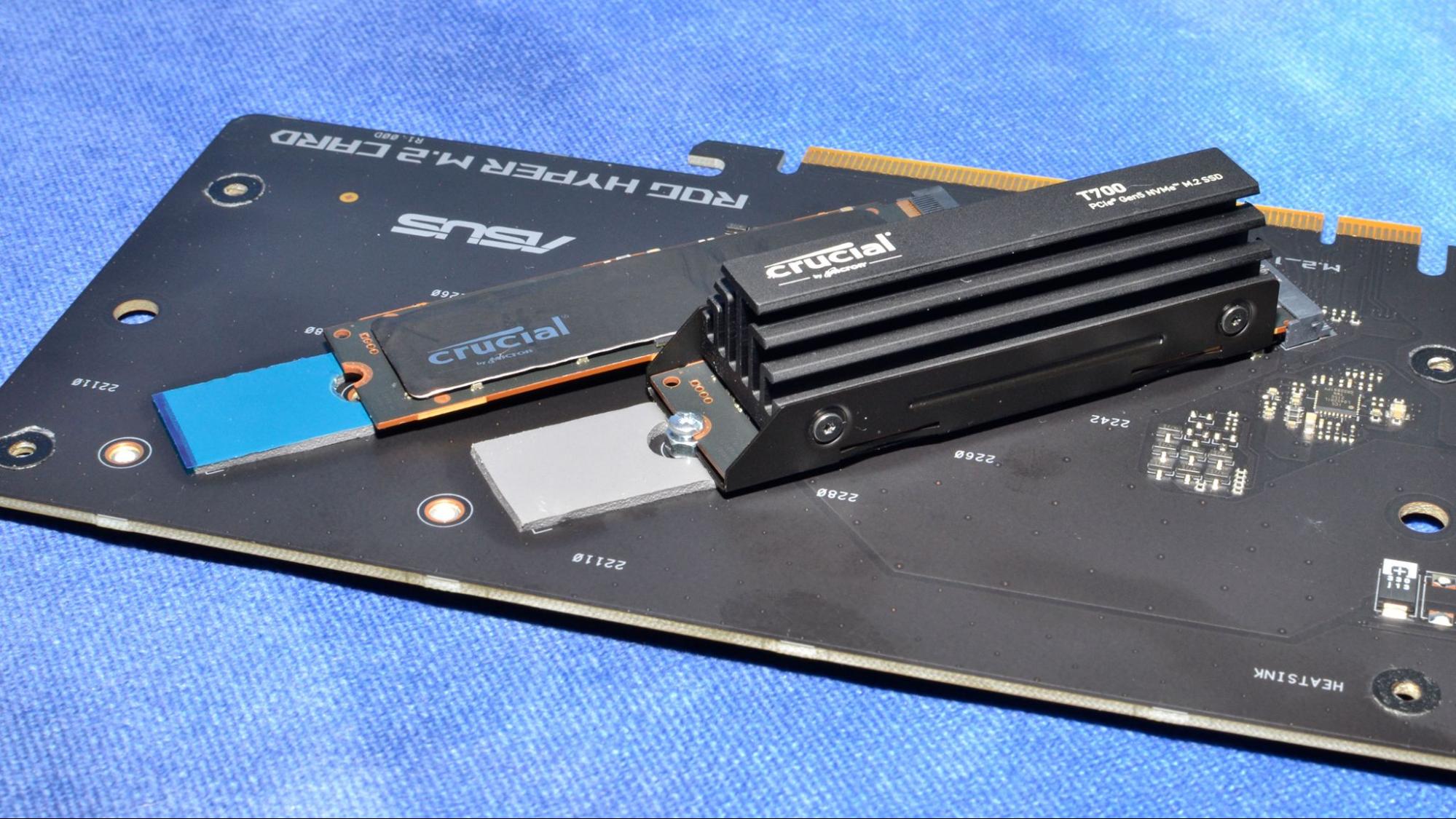
The Crucial T700 sample we have in the labs today is unquestionably the fastest consumer SSD in the world, at least for now, delivering up to a blistering 12.4 GB/s of sequential throughput and 1.5 million random IOPS over the PCIe 5.0 interface. That's 70% faster than today's highest-end PCIe 4.0 SSDs, and 20% faster than the current crop of PCIe 5.0 drives.
The T700 is slated to be the first of a new set of faster PCIe 5.0 SSDs that offer even better performance than what we saw with the initial PCIe 5.0 SSD we covered in our Phison E26 SSD controller preview. The T700 uses the Phison E26 SSD controller, a robust design used in several other 5.0 SSDs, paired with speedy 232-Layer TLC flash, thus creating the fastest SSD we’ve ever tested in our labs. Impressively, it delivers this level of performance with passive cooling thanks to its well-designed heatsink, but if you remove the heatsink the SSD will also work well in motherboards with proper M.2 heatsink coverage.
The drive also comes with DirectStorage enabled, which will allow games that support the feature to deliver the utmost in performance. Crucial provided an early T700 sample to us for testing, and the drives will launch in a few months (by the end of the second quarter). Let's see what they'll look like when they arrive.
Specifications
The Crucial T700 delivers up to 12.4 / 11.8 GBps of sequential read/write throughput and 1.5 / 1.5 million IOPS in random read/write workloads with the 2TB and larger models (the 1TB model is slightly slower). The drive will be available in 1TB, 2TB, and 4TB capacities, with pricing yet to be determined. Crucial backs the drive with a five-year warranty and endurance of 600TB of writes per 1 TB of capacity.
The drive supports AES-256 encryption and TCG Opal 2.01, including for crypto erase (TCG OPAL was not implemented at the time of testing). Crucial also has other optimizations in the works, but the drives we're testing are considered Engineering Samples (ES), so the firmware is not final. Crucial expects that performance in random write workloads will improve in the future.
Software and Accessories
Crucial offers its own Crucial Storage Executive SSD toolbox with the typical features you would expect. The utility includes drive information, SMART attributes, firmware updates, secure erase/sanitize, overprovisioning, and other features related to encryption. The T700 is not explicitly supported per Crucial’s website, but this will likely change when the drive arrives at retail. Third-party software like CloneZilla is recommended for cloning and imaging.
A Closer Look
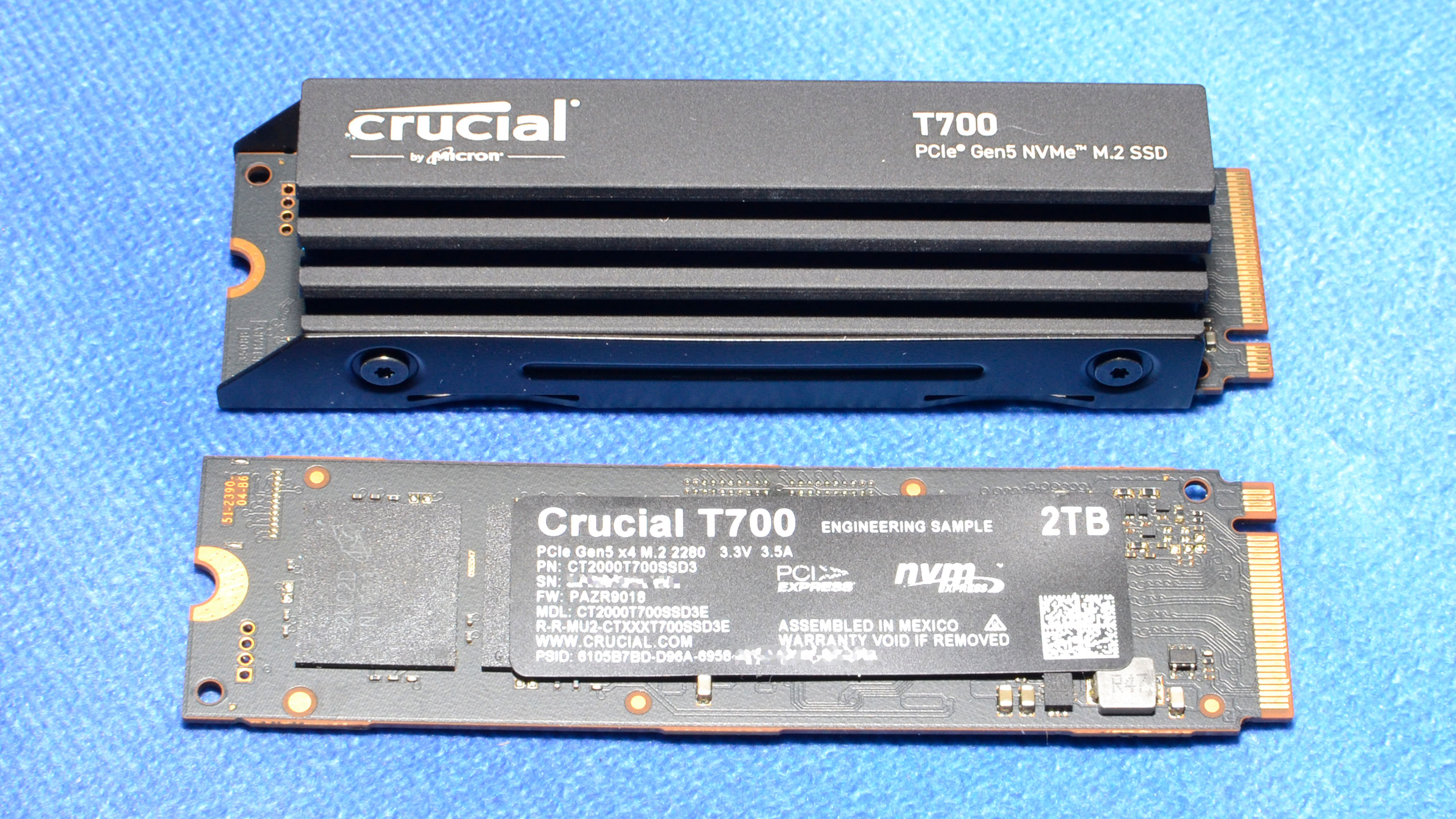
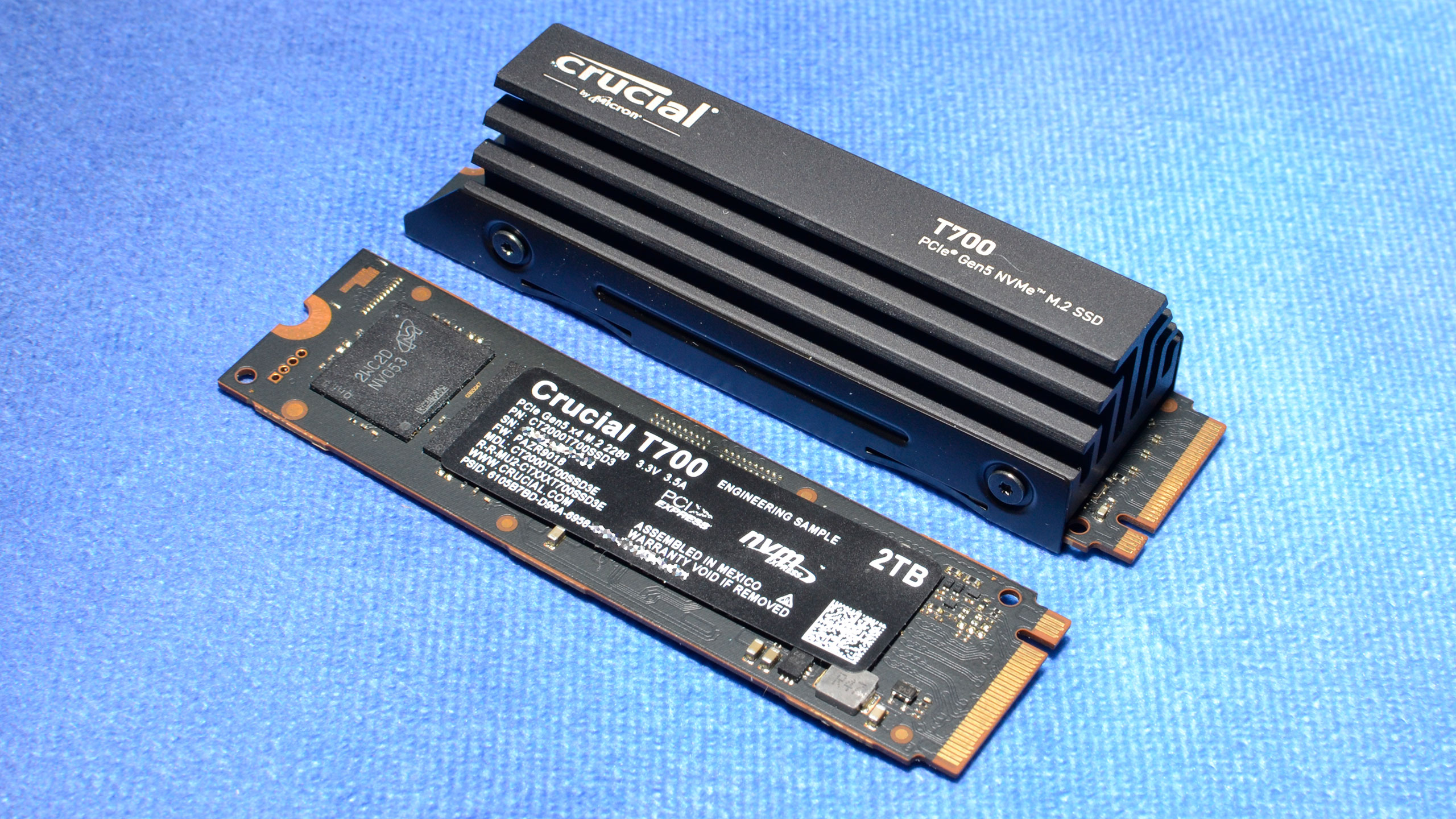
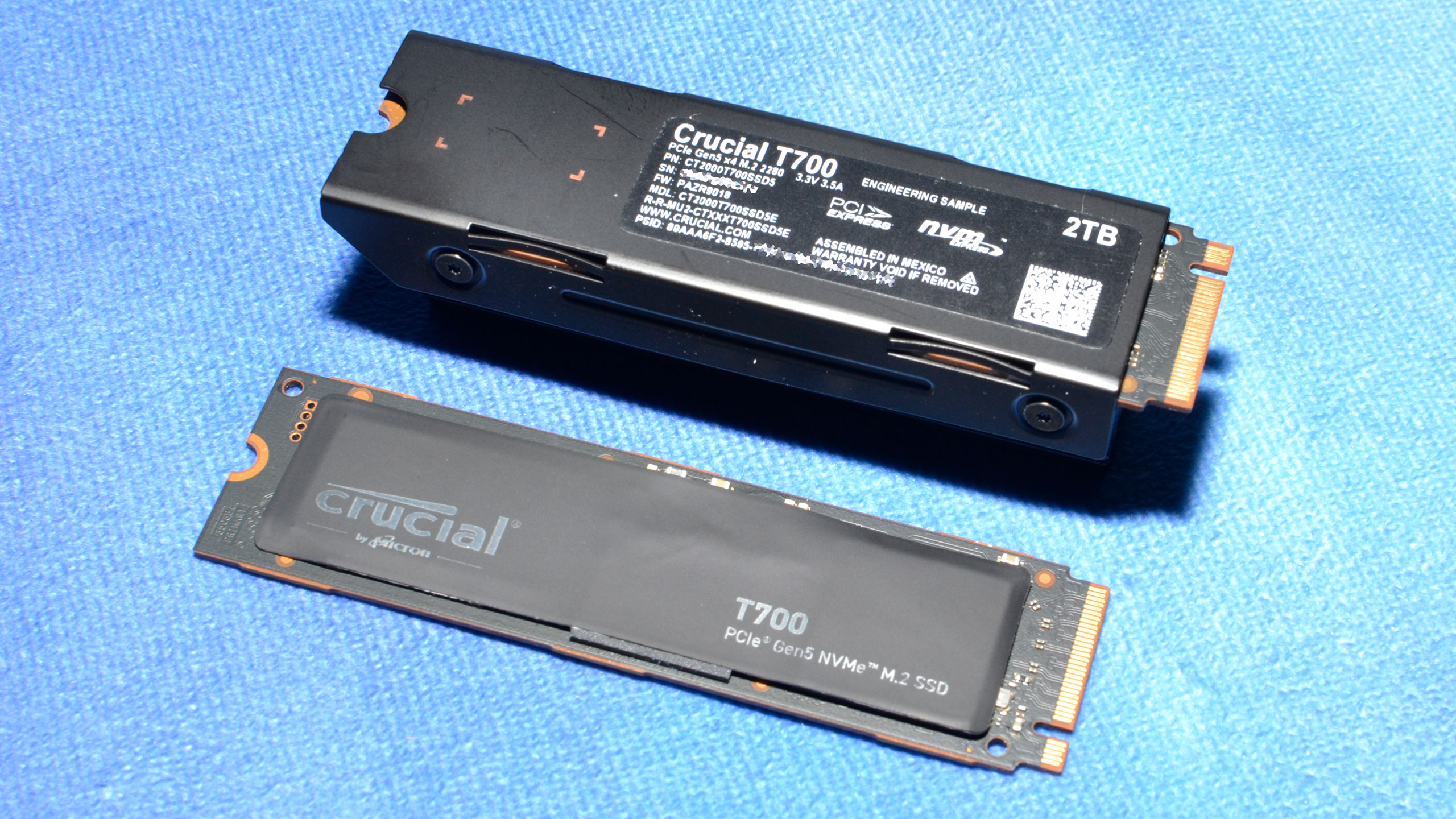
The T700 comes with or without a heatsink, depending on your needs. If your motherboard already has a substantial M.2 heatsink, or if you want to install your own solution, the bare drive is an option. In that case, the drive has a copper thermal label that is not intended to be removed. This SSD is not intended to be used without a heatsink, such as in a laptop or PlayStation 5.
The default model comes with a pyramidal, central T-pose heatsink designed to keep the drive cool without any (direct) active cooling. The heatsink is constructed of multiple materials and has air channels to maximize heat dissipation via airflow in the case. The SSD components — SSD controller, NAND flash, power management integrated circuit (PMIC), and voltage regulators — have good contact with the heatsink via thermal material. The back side of the heatsink is nickel-plated copper that provides support and heat spreading, while the top is aluminum with a significant amount of surface area for heat dissipation.
All T700 models are double-sided with two NAND packages per side, for a total of four. The top of the SSD has the requisite SSD controller package and a single DRAM package.
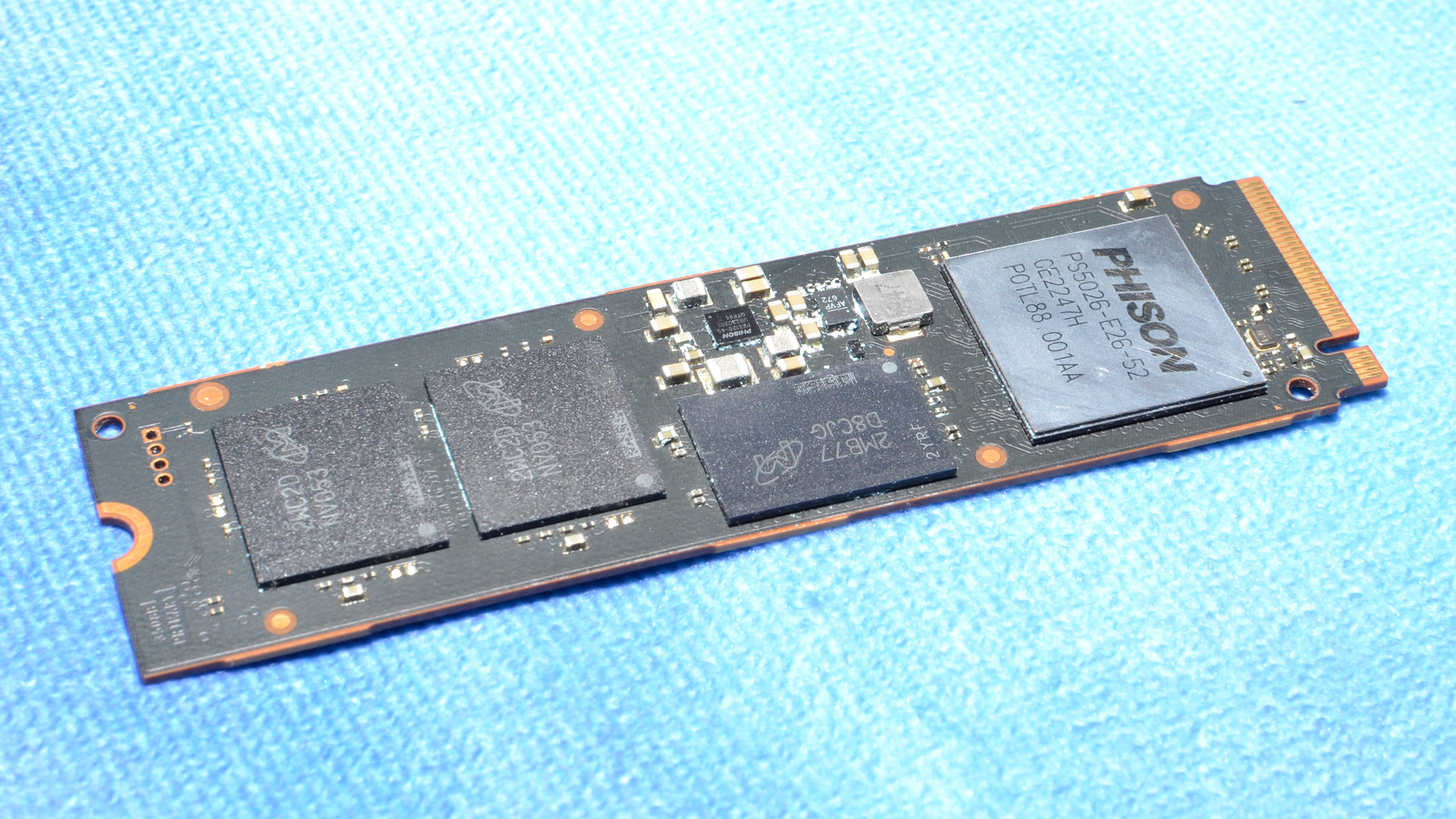
The Phison E26 is the first consumer PCIe 5.0 SSD controller to hit the market. We previously conducted preview testing of an engineering sample, and now a whole host of drives are arriving with this controller on board. This controller has DirectStorage-optimized firmware, which we also previewed before its official release. That firmware has already found its way into one PCIe 4.0 SSD, the Sabrent Rocket 4 Plus-G.
The T700 is not the first PCIe 5.0 SSD on the market, as the Inland TD510 has been out for a while. The T700 is also not the first to be announced by a big brand name, as we can see with the Corsair MP700. However, the T700 is the fastest implementation of the E26, as it can reach up to 12.4 GBps in sequential read workloads thanks to its speedier flash with an I/O speed of 2000 MT/s. This is in contrast to the 1600 MT/s flash used in the earlier E26 SSDs, limiting them to around 10 GBps. The E26 controller supports up to 2400 MT/s flash, which would put a cap of around 15 GBps. But for now, the T700 is the fastest around.
The T700 has DRAM identified as D7CJG, meaning this is LPDDR4 in a 1G x 32b configuration. LPDDR4 is more power efficient than DDR4 memory (we saw the benefit of LPDDR4X in our Lexar Professional NM800 Pro review). In this configuration, we have 4GB of DRAM for 2TB of NAND, the same as in our E26 preview. There may be reasons for such a high memory-to-flash ratio, but we'll have to review the amount used with other capacities.
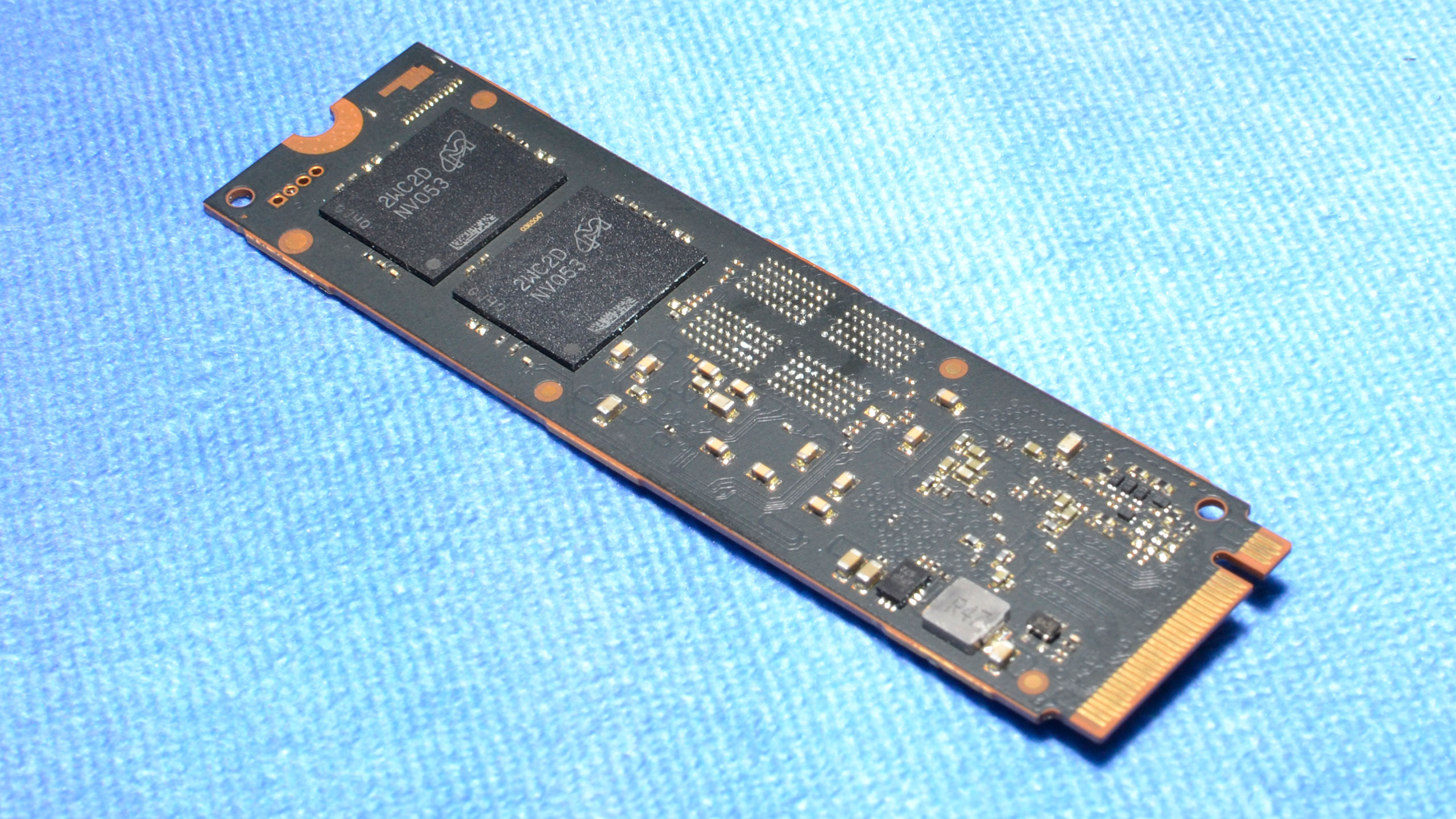
The 232-Layer Micron TLC (B58R) flash takes up the mantle from Micron’s very successful 176-Layer TLC (B47R). Micron has gone from four planes to six and has made other improvements that make multi-planar operations faster for superior internal parallelization. The move to 1Tb (128GB) dies over 512Gb (64GB) is also an important consideration for capacity: bigger dies, more storage.
Denser dies also mean less relative parallelization for the same capacity because fewer dies are required. This is mitigated to some extent by the increase in internal parallelization, or planes. The T700 can still reach peak performance at 2TB like older PCIe 4.0 SSDs, but has the opportunity to be better at 4TB as well, depending on multi-planar optimizations. The performance of TLC flash during sustained write workloads could also improve without a corresponding improvement to read latency, although read performance as a whole should improve due to independent plane advancements.
MORE: Best SSDs
MORE: Best External SSDs and Hard Drives
MORE: How We Test HDDs And SSDs
MORE: All SSD Content
Comparison Products
Besides the prototype Phison E26 ES, the Crucial T700 is also up against the Gigabyte Aorus Gen5 10000, the Inland TD510, the Sabrent Rocket 4 Plus-G, the Adata Legend 960, the Corsair MP600 Pro LPX, the Crucial P5 Plus, the Samsung 990 Pro, and the Solidigm P44 Pro. We've tested all of those, though we haven't yet reviewed the Aorus and Inland models.
Trace Testing - 3DMark Storage Benchmark
Built for gamers, 3DMark’s Storage Benchmark focuses on real-world gaming performance. Each round in this benchmark stresses storage based on gaming activities including loading games, saving progress, installing game files, and recording gameplay video streams.
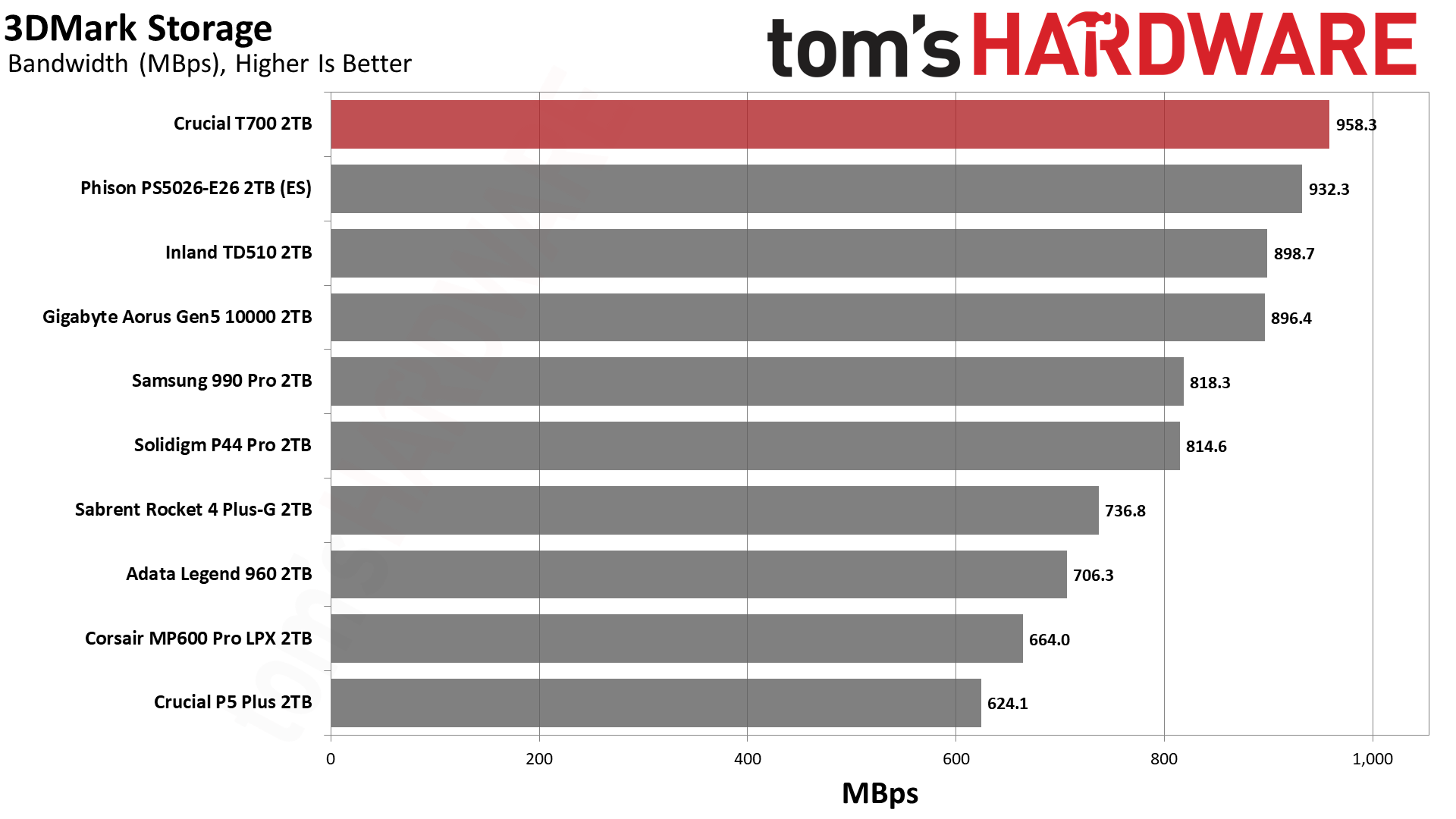
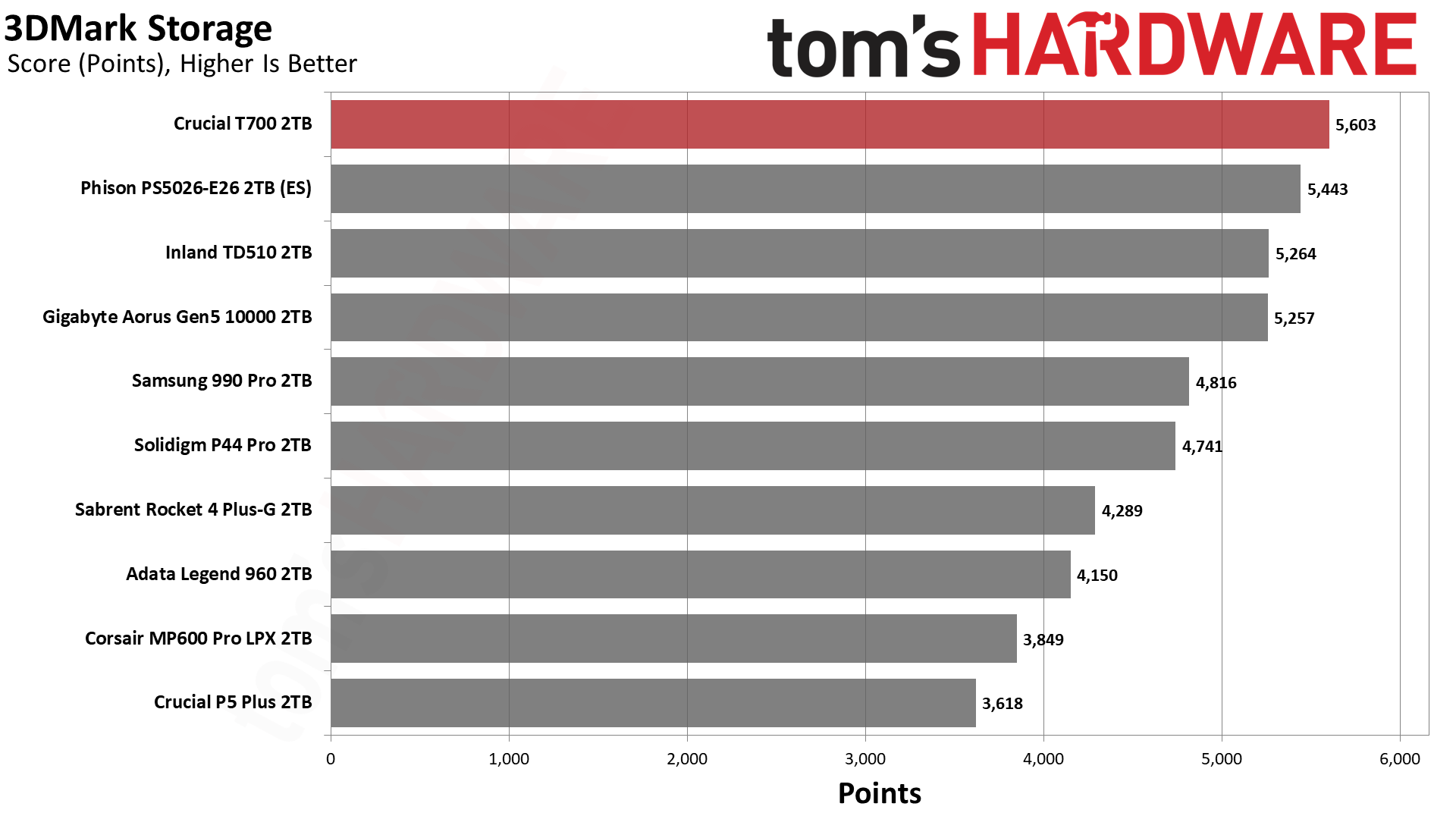
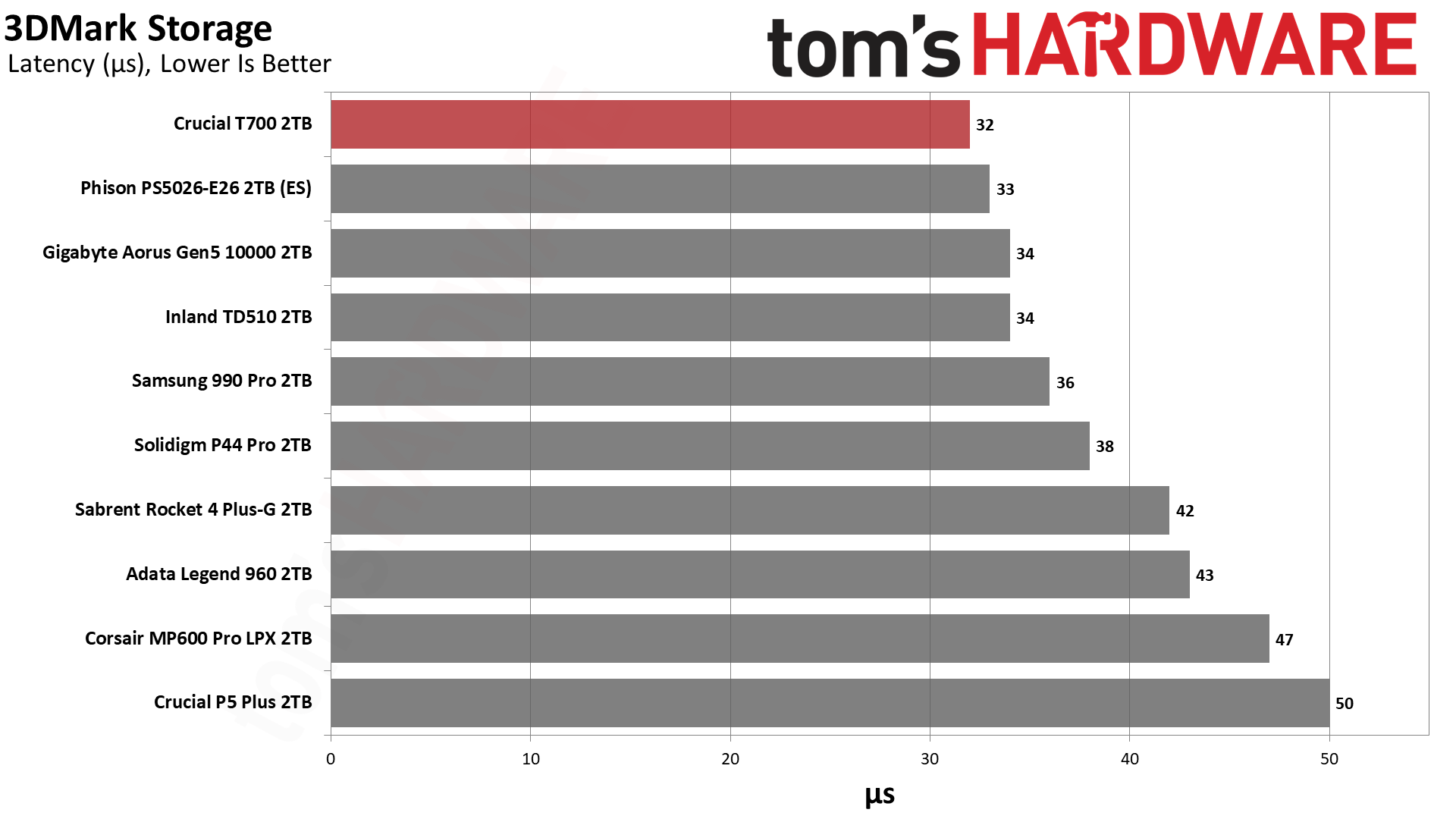
The T700 is the fastest drive we’ve tested in 3DMark, just barely edging out the Phison PCIe 5.0 E26 sample that we tested before the official launch. The T700's performance leap over Crucial’s last flagship, the P5 Plus, is significant. The other two currently shipping Gen5 drives (Inland TD510 and Aorus Gen5 10000) come in slightly behind the E26 engineering sample, with nearly identical performance — no surprise, since those two feature identical components.
Trace Testing – PCMark 10 Storage Benchmark
PCMark 10 is a trace-based benchmark that uses a wide-ranging set of real-world traces from popular applications and everyday tasks to measure the performance of storage devices.
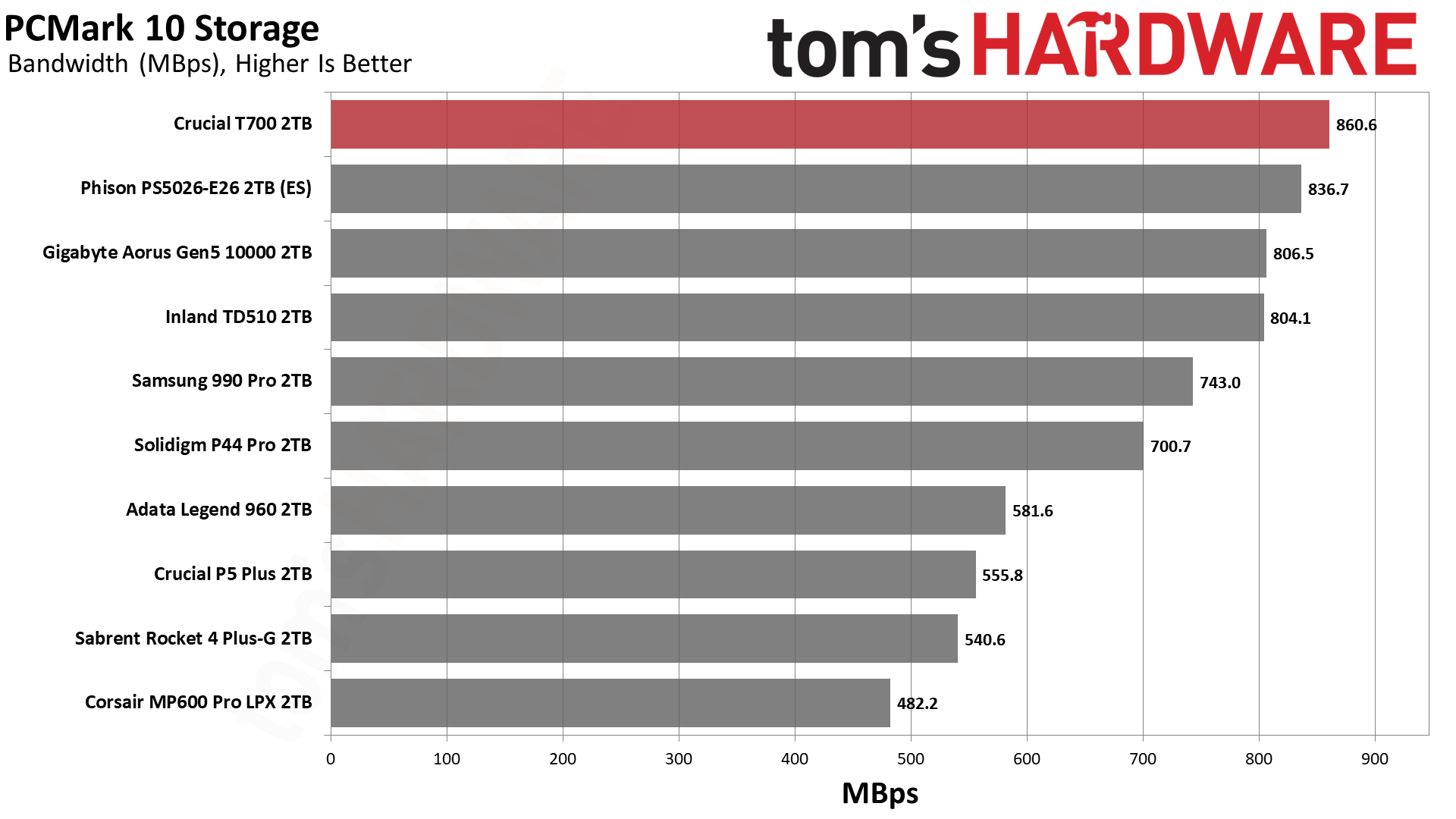
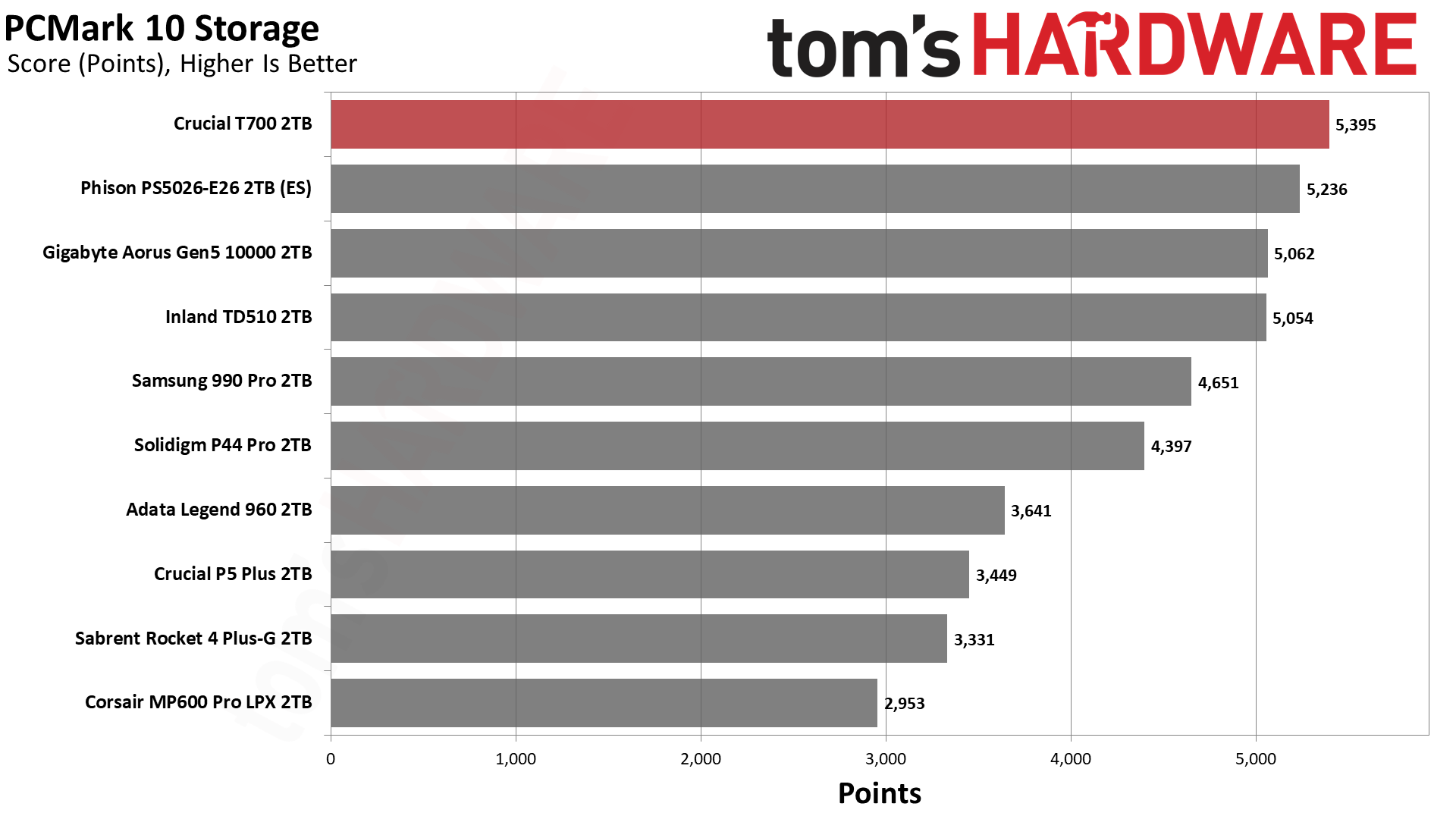
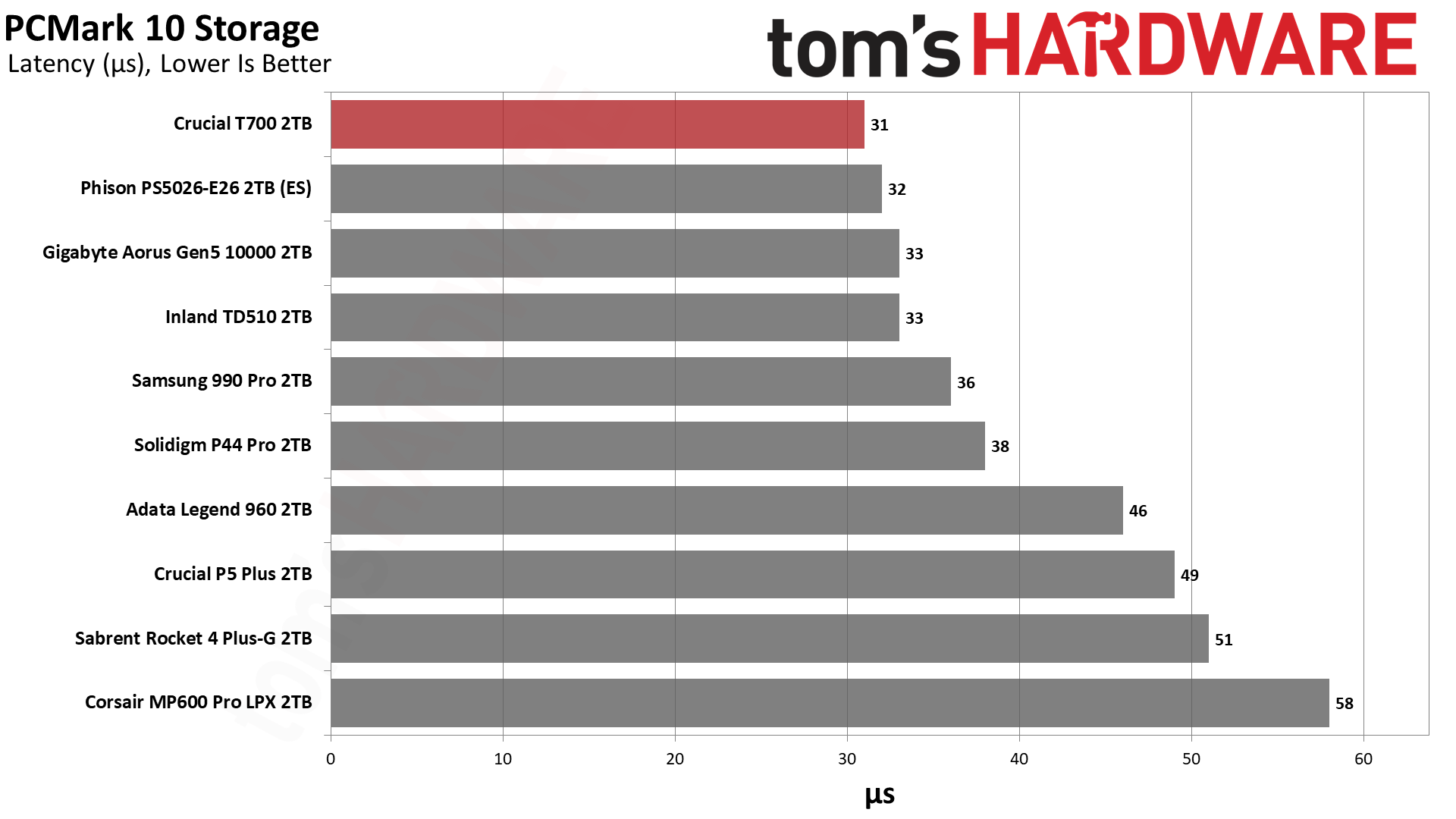
The T700 is also the fastest drive we’ve tested to date in PCMark 10. It provides a significant advantage over PCIe 4.0 SSDs, although it doesn't take a massive leap over the Phison engineering sample, which again outpaces the Aorus and Inland models.
Transfer Rates – DiskBench
We use the DiskBench storage benchmarking tool to test file transfer performance with a custom 50GB dataset. We copy 31,227 files of various types including pictures, PDFs, and videos to a new folder. A secondary test copies those same files from the drive to itself (so it's both reading and writing data simultaneously). Finally, we follow-up with a reading test of a newly-written 6.5GB zip file.
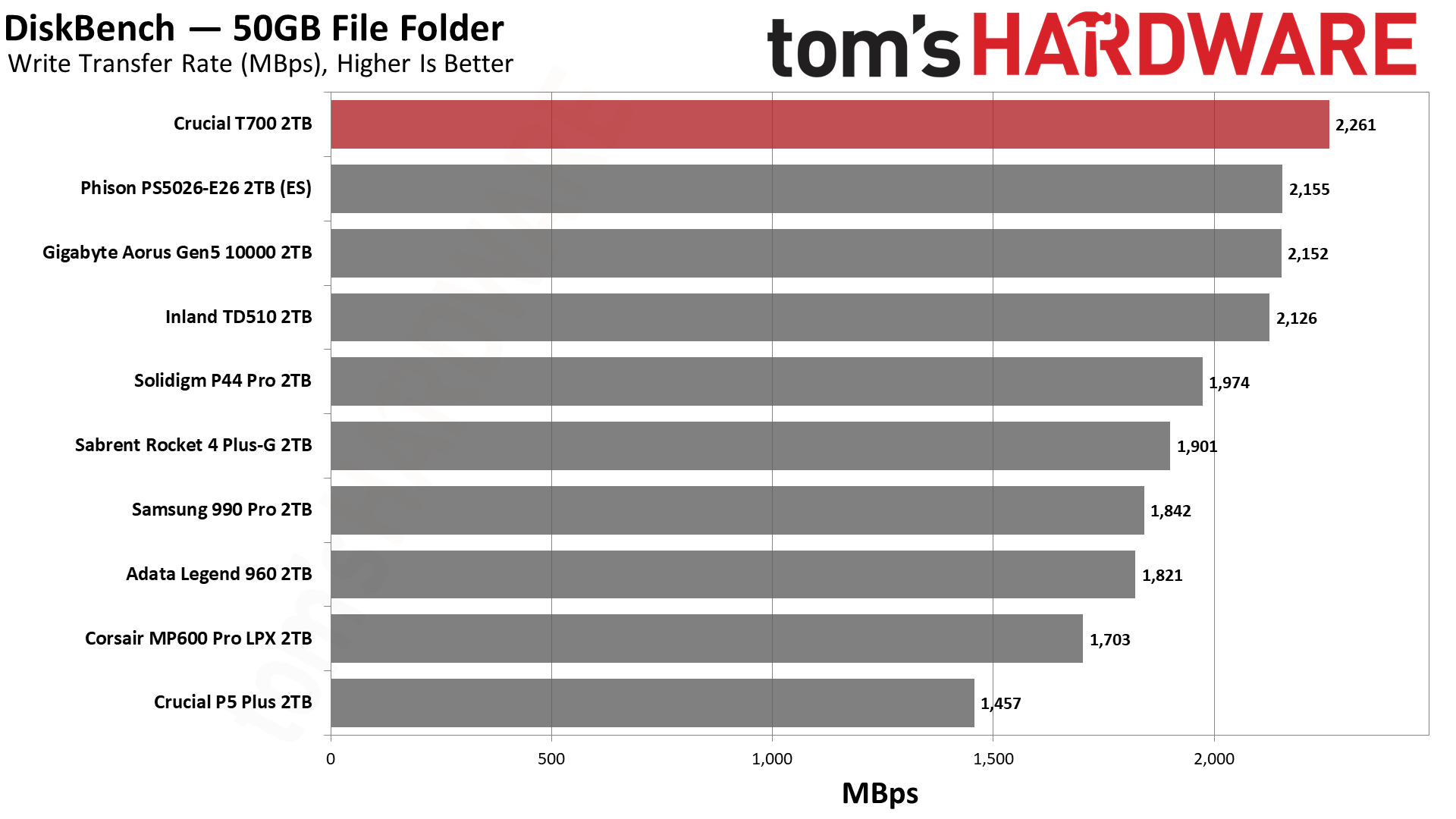
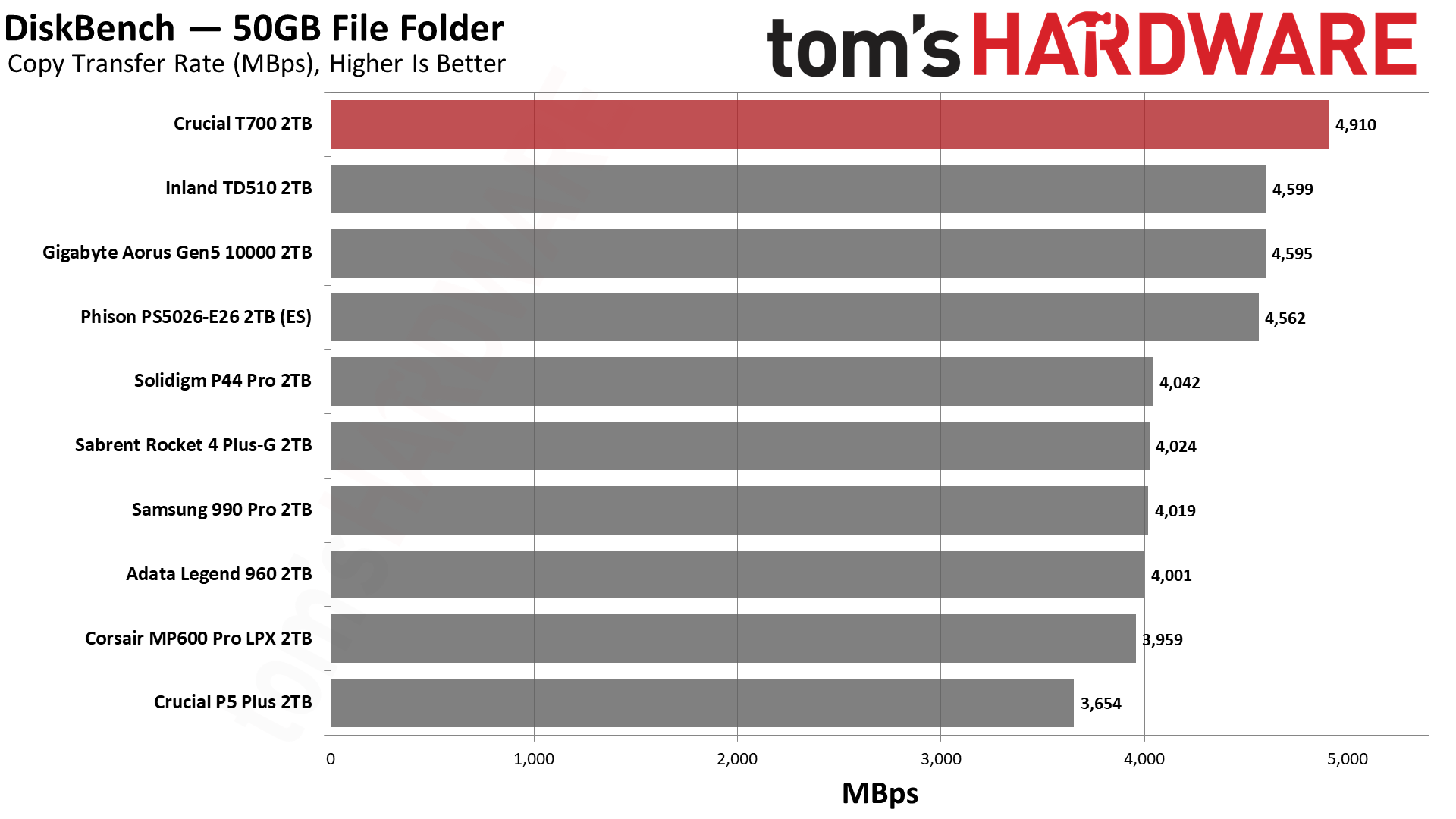
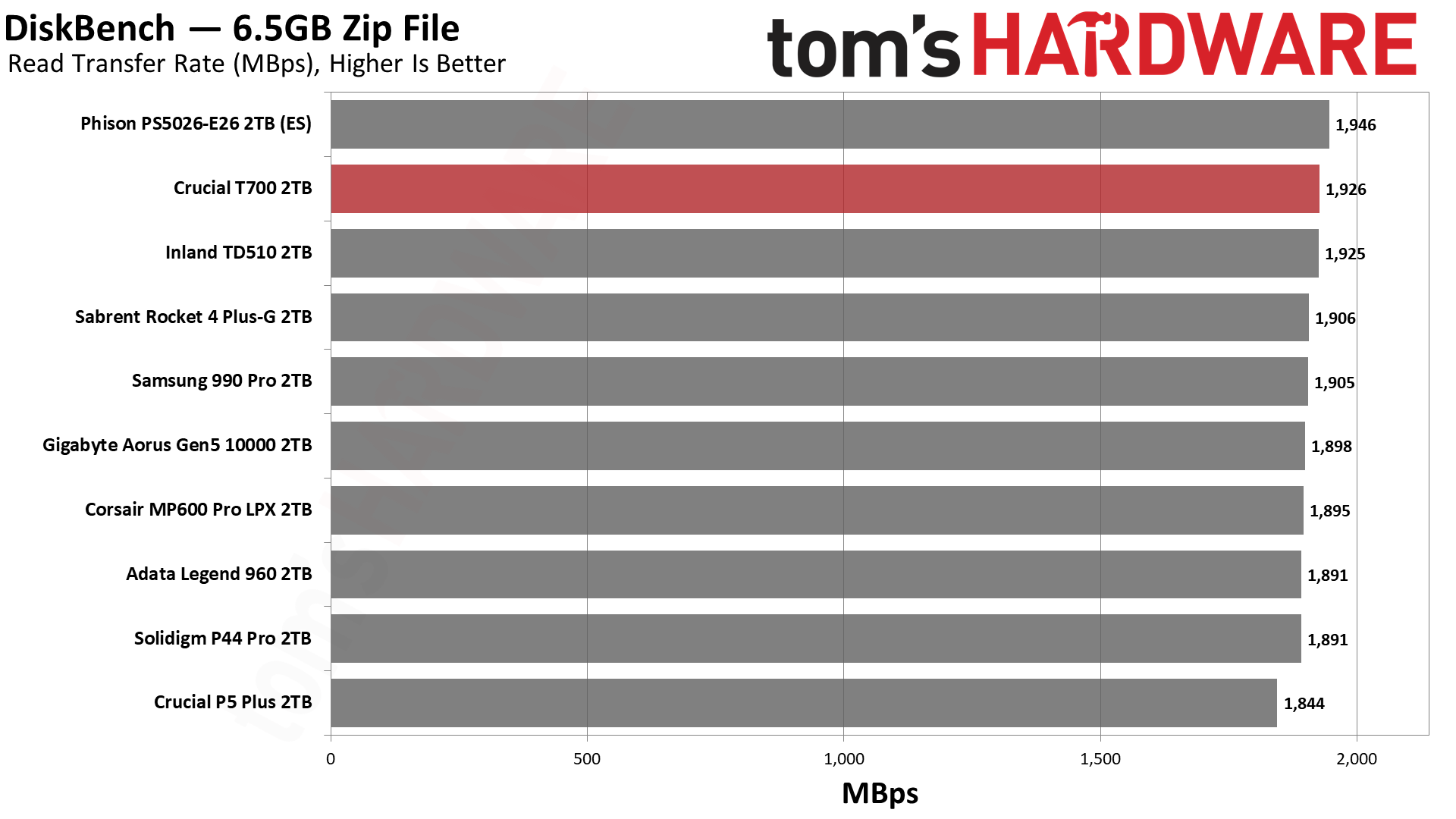
The T700 copies at very high speeds, even significantly faster than the Phison E26 sample. This time the Phison sample basically ties the Aorus and Inland drives.
Synthetic Testing - ATTO / CrystalDiskMark
ATTO and CrystalDiskMark (CDM) are free and easy-to-use storage benchmarking tools that SSD vendors commonly use to assign performance specifications to their products. Both of these tools give us insight into how each device handles different file sizes.
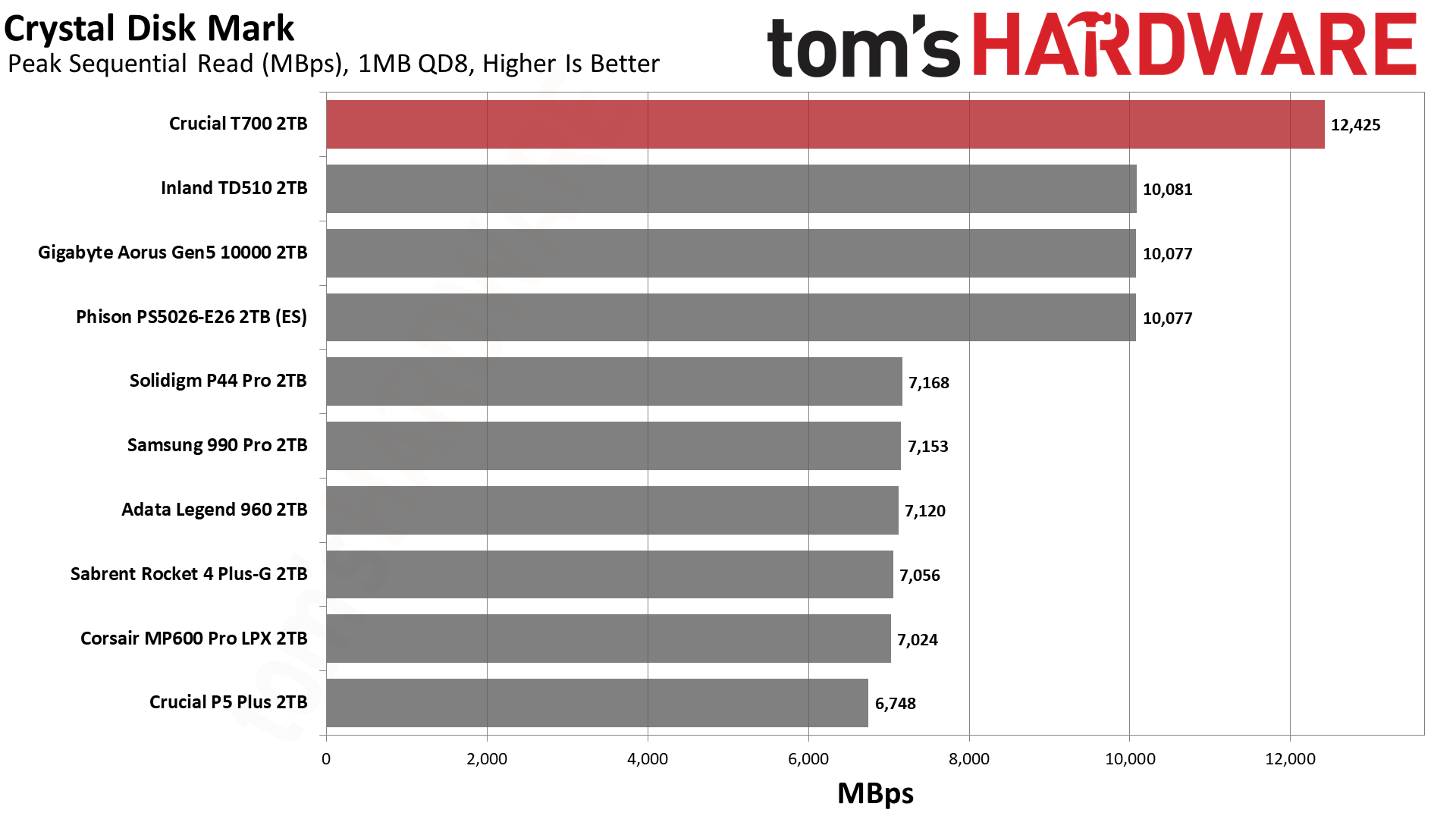
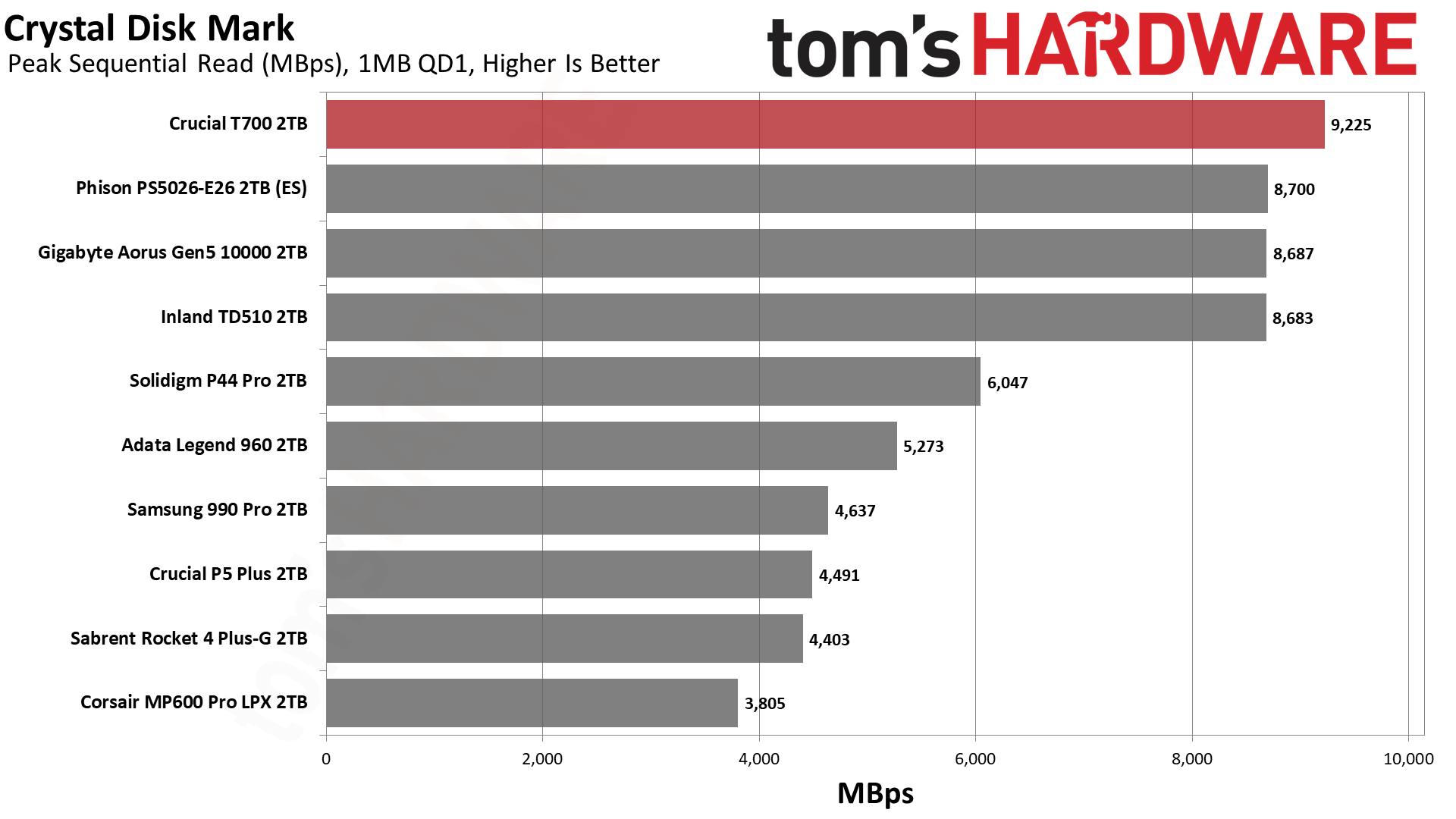
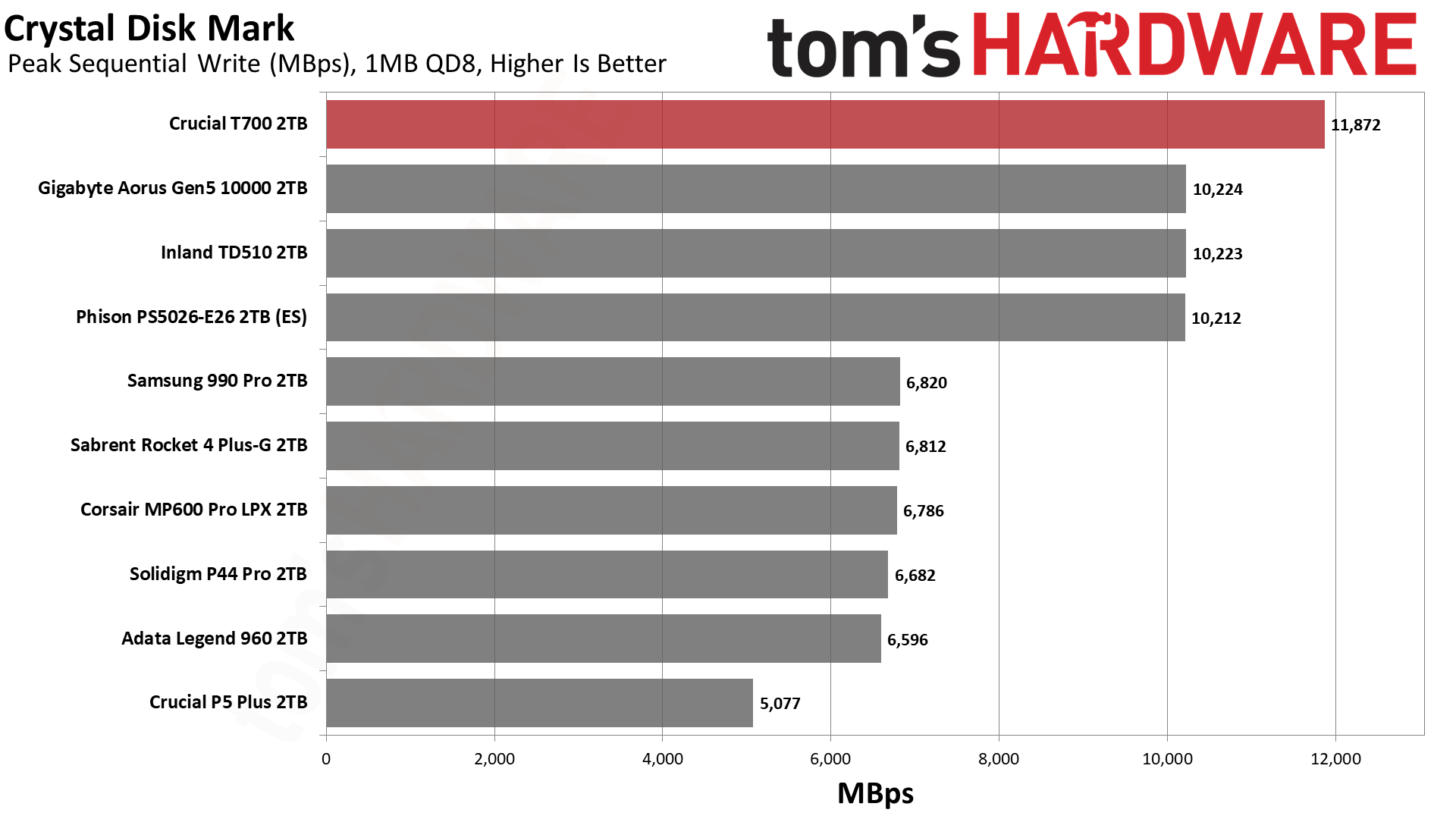
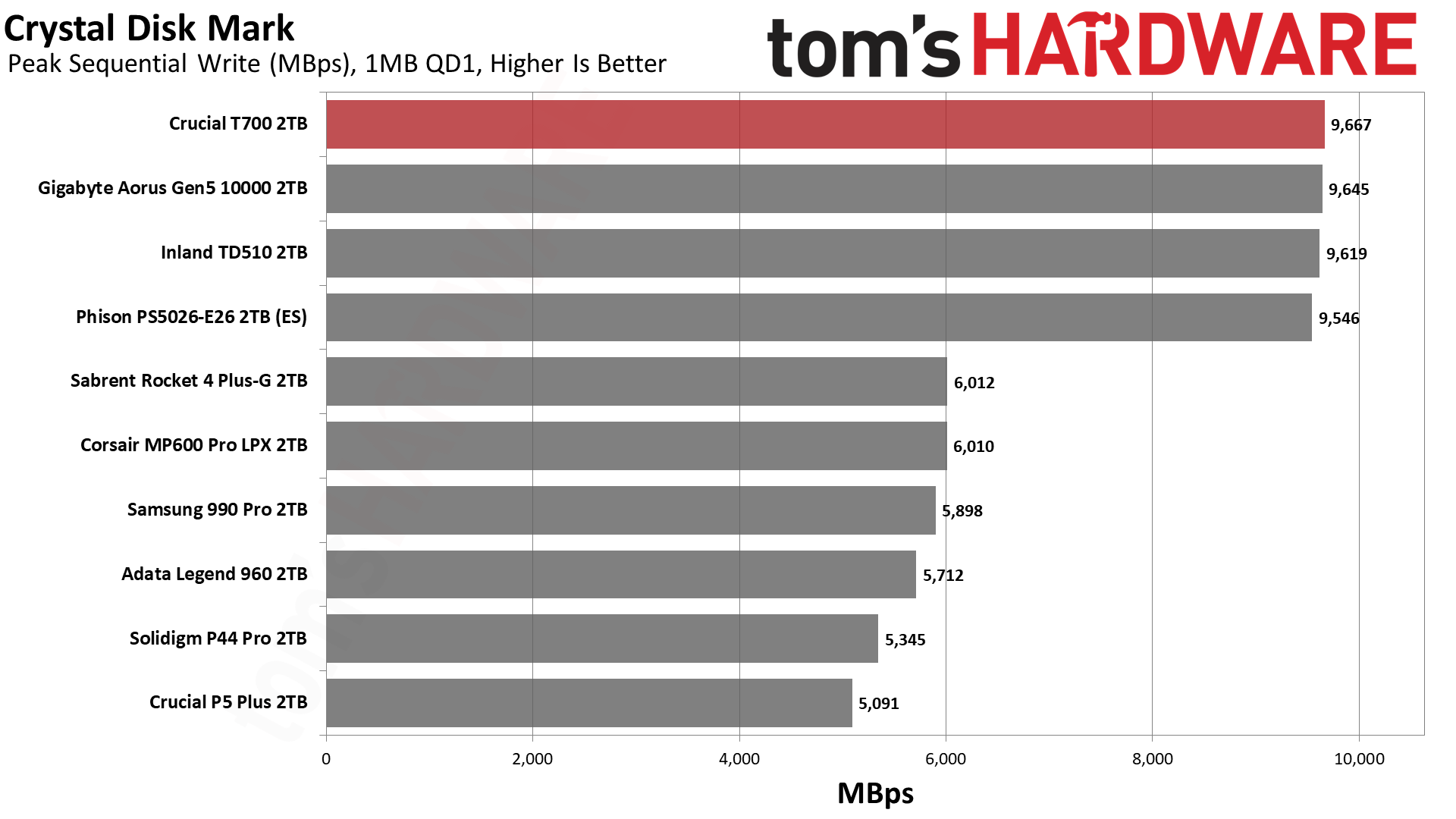
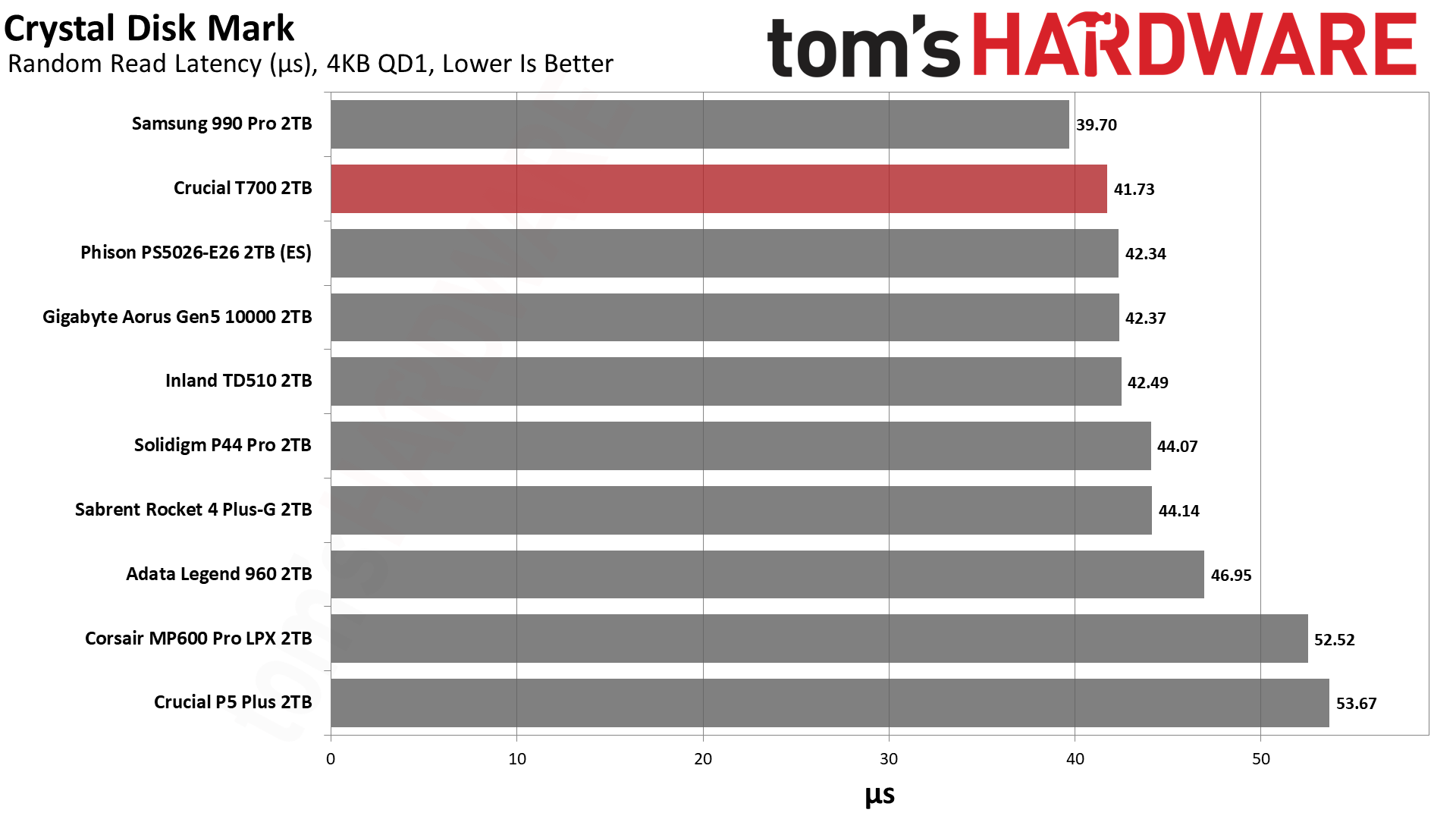
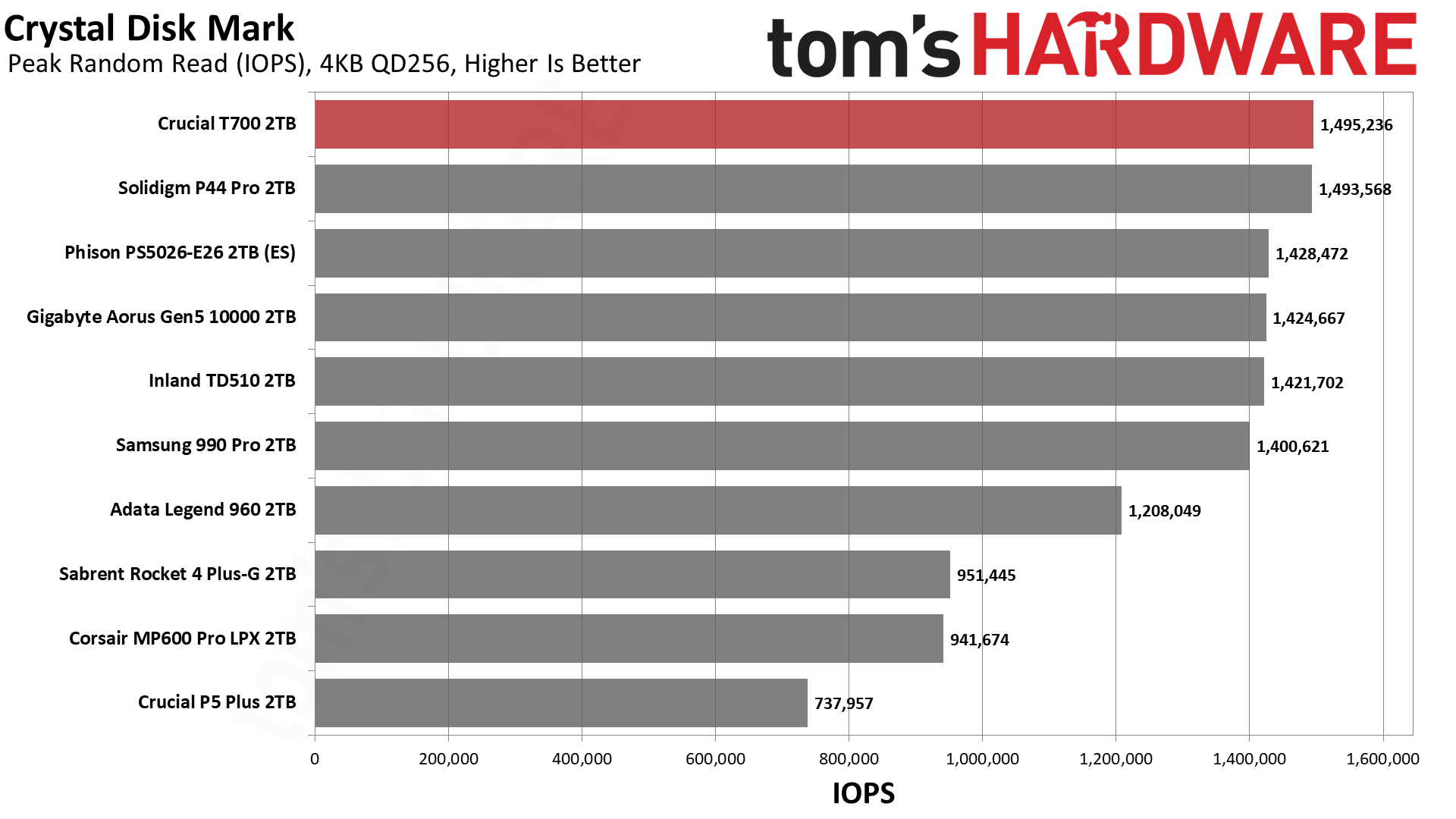
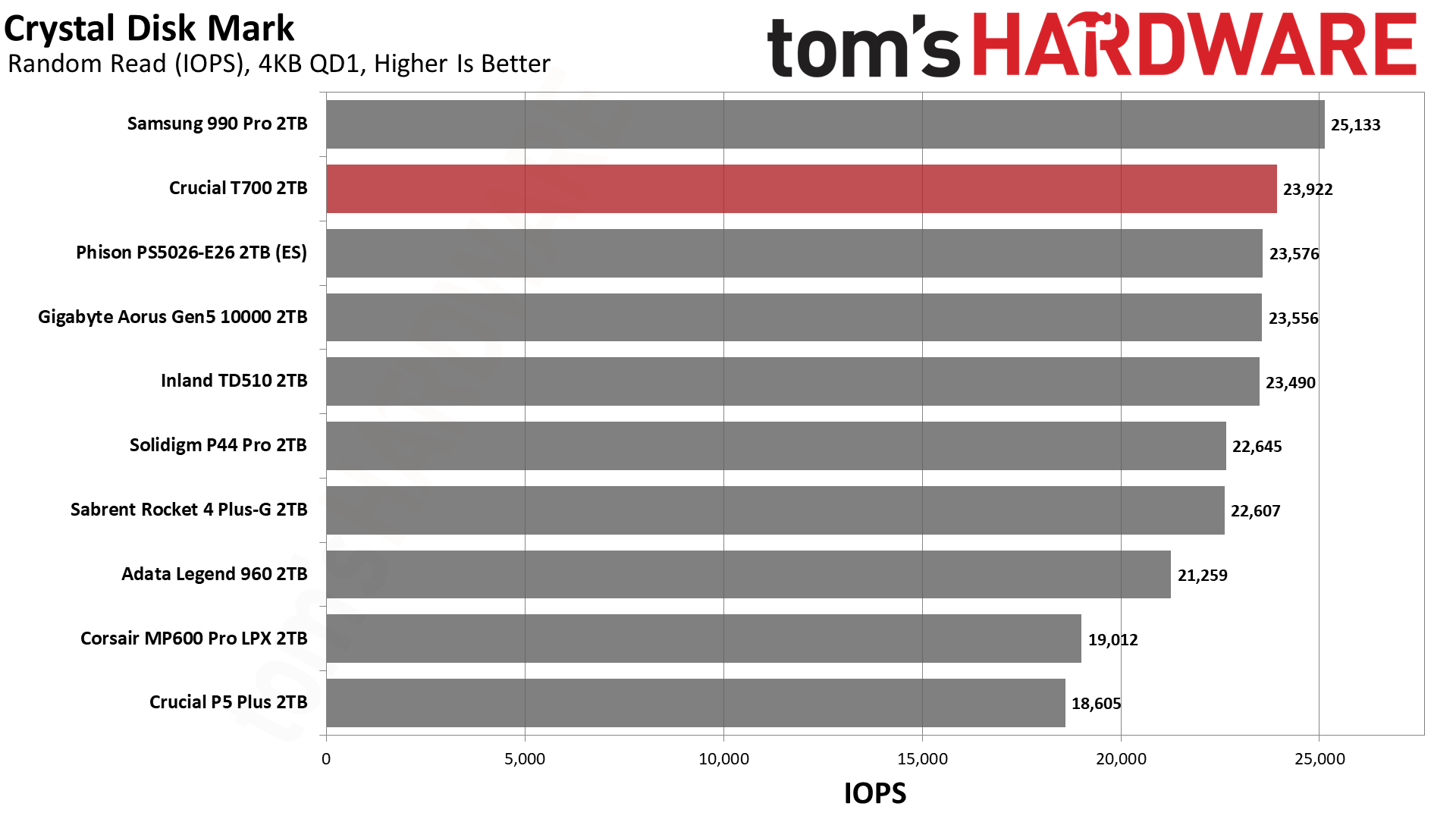
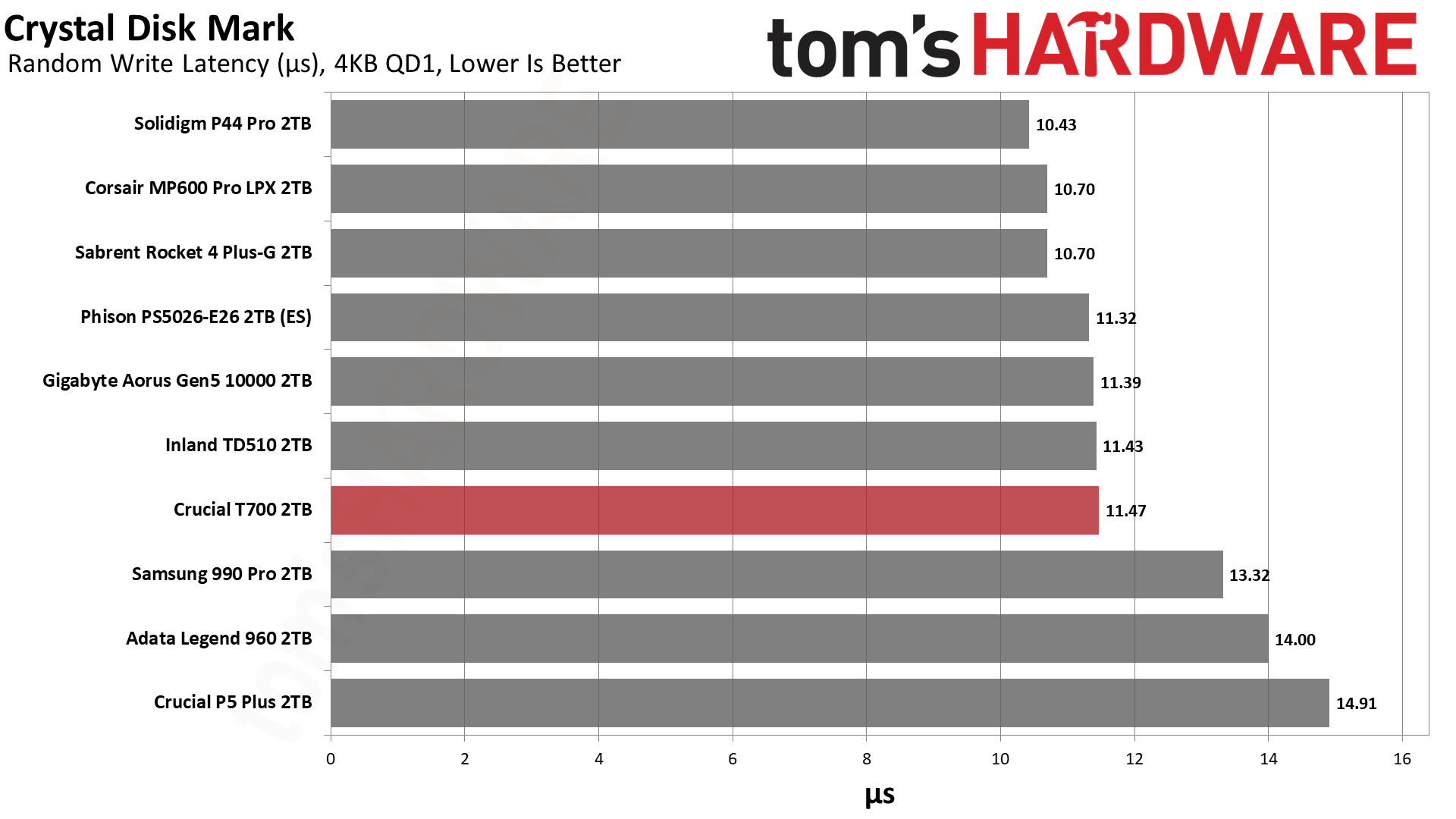
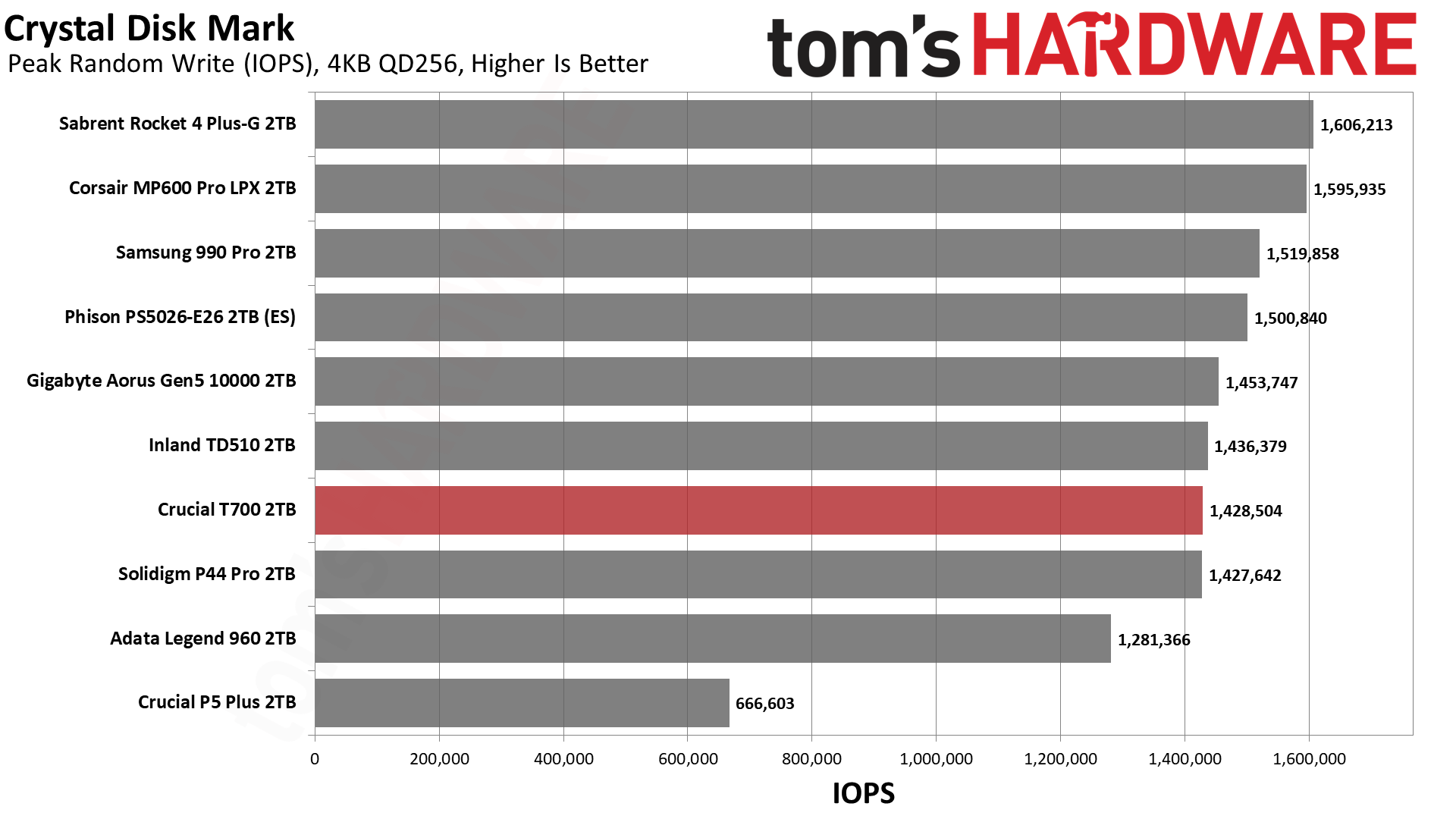
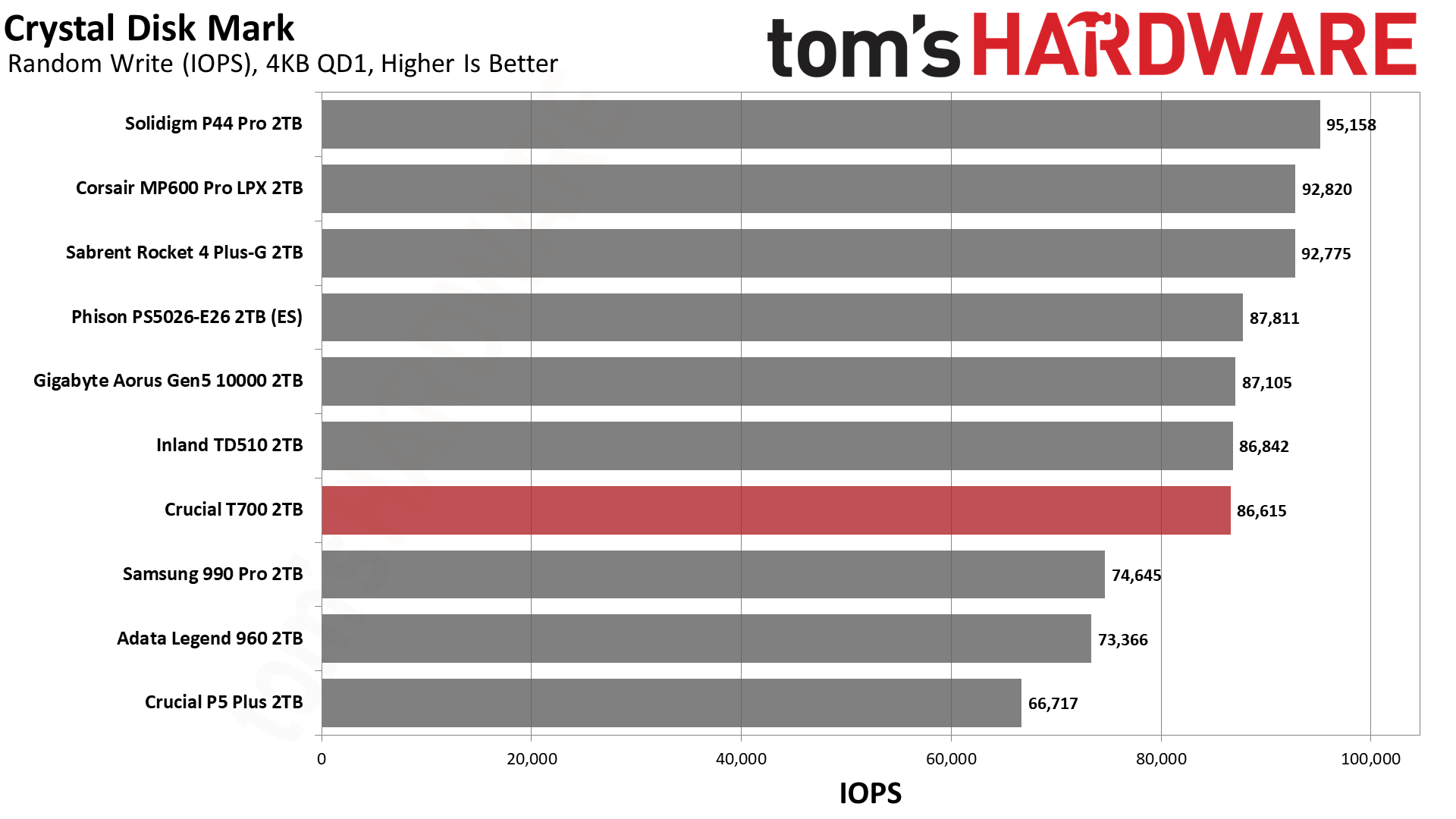
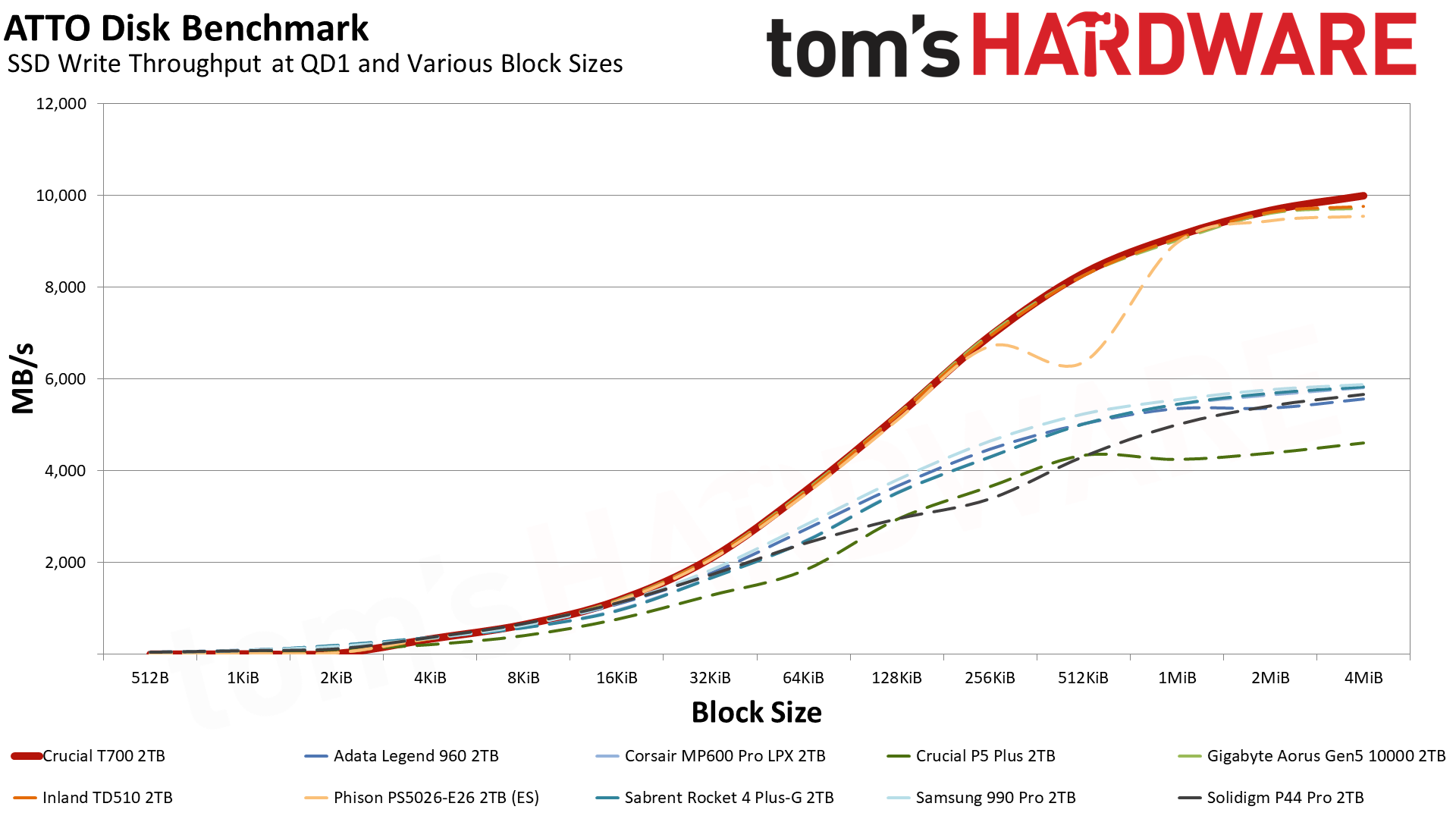
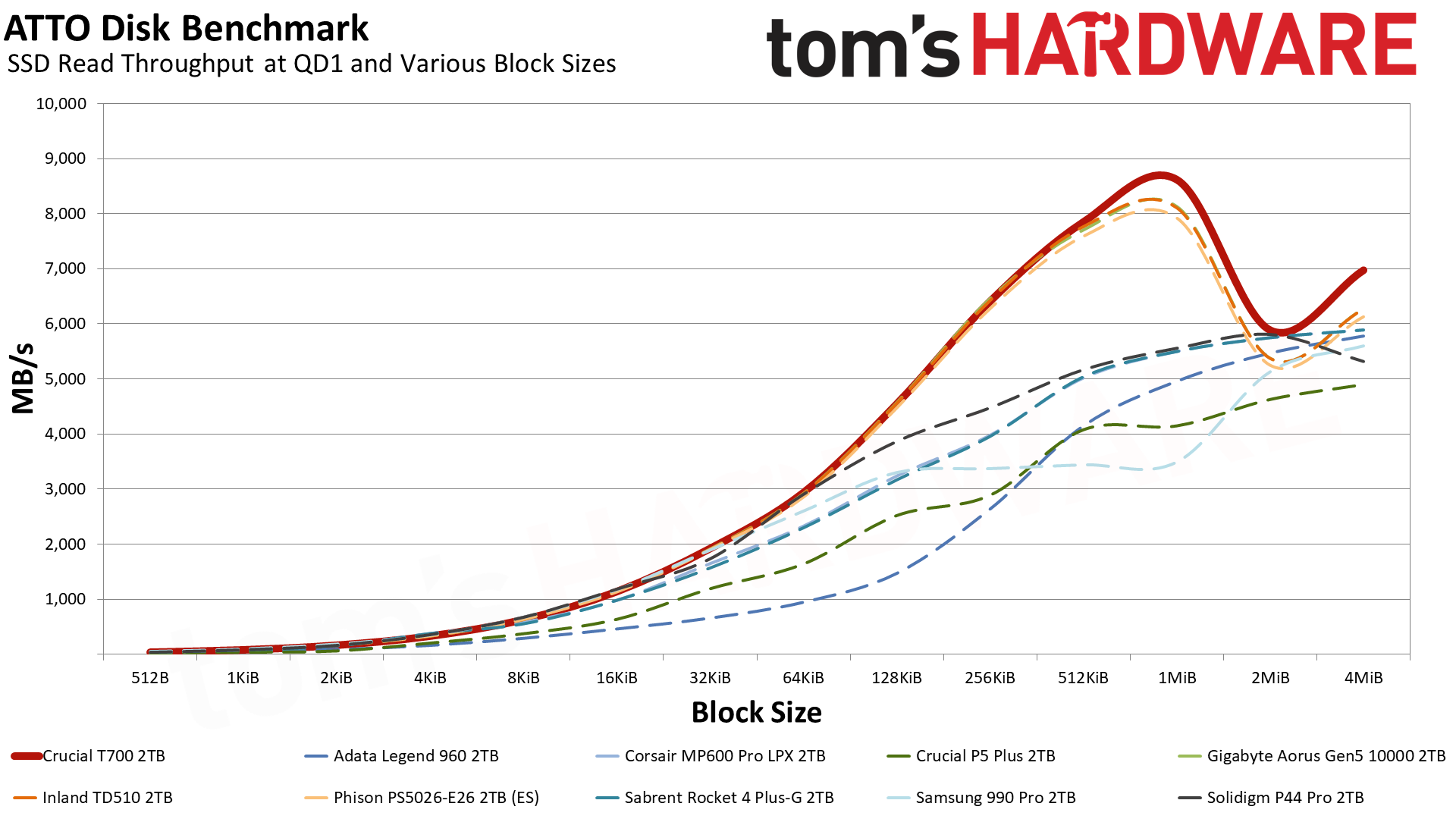
The T700 does require its heatsink to perform properly, especially during tougher or prolonged tests. Nevertheless, the T700 smooths out the bumps we saw with the Phison E26 sample in ATTO and sets all-time highs. Likewise, the drive also provides improved sequential throughput in the CrystalDiskMark benchmark.
We expect fewer improvements in 4K random workloads as this drive mainly benefits from a faster bus, and this bears out: Random read and write latencies see little to no improvement over PCIe 4.0 drives.
Sustained Write Performance and Cache Recovery
Official write specifications are only part of the performance picture. Most SSDs implement a write cache, which is a fast area of (usually) pseudo-SLC programmed flash that absorbs incoming data. Sustained write speeds can suffer tremendously once the workload spills outside of the cache and into the "native" TLC or QLC flash.
We use Iometer to hammer the SSD with sequential writes for (over) 15 minutes to measure both the size of the write cache and performance after the cache is saturated. We also monitor cache recovery via multiple idle rounds.
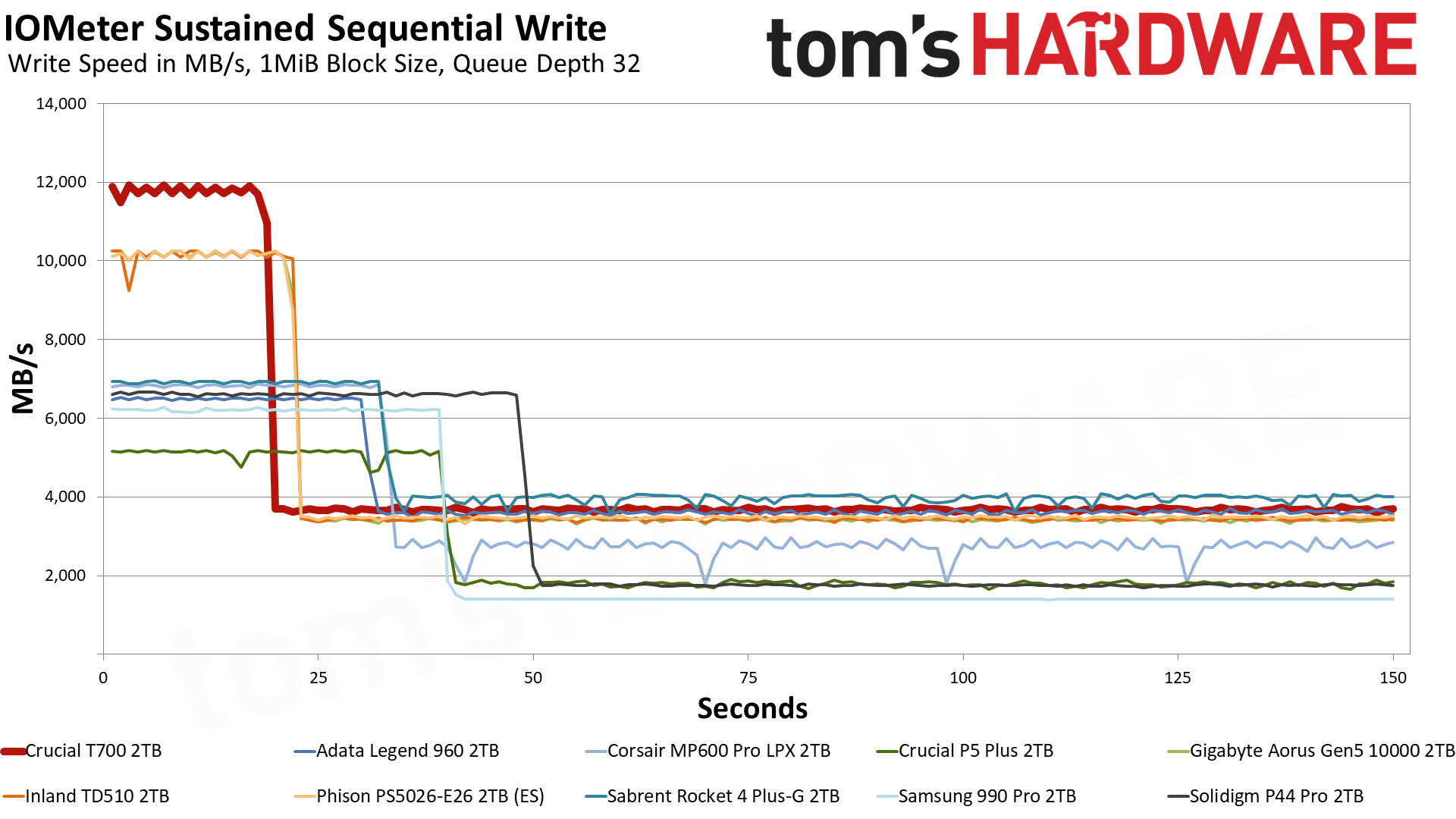
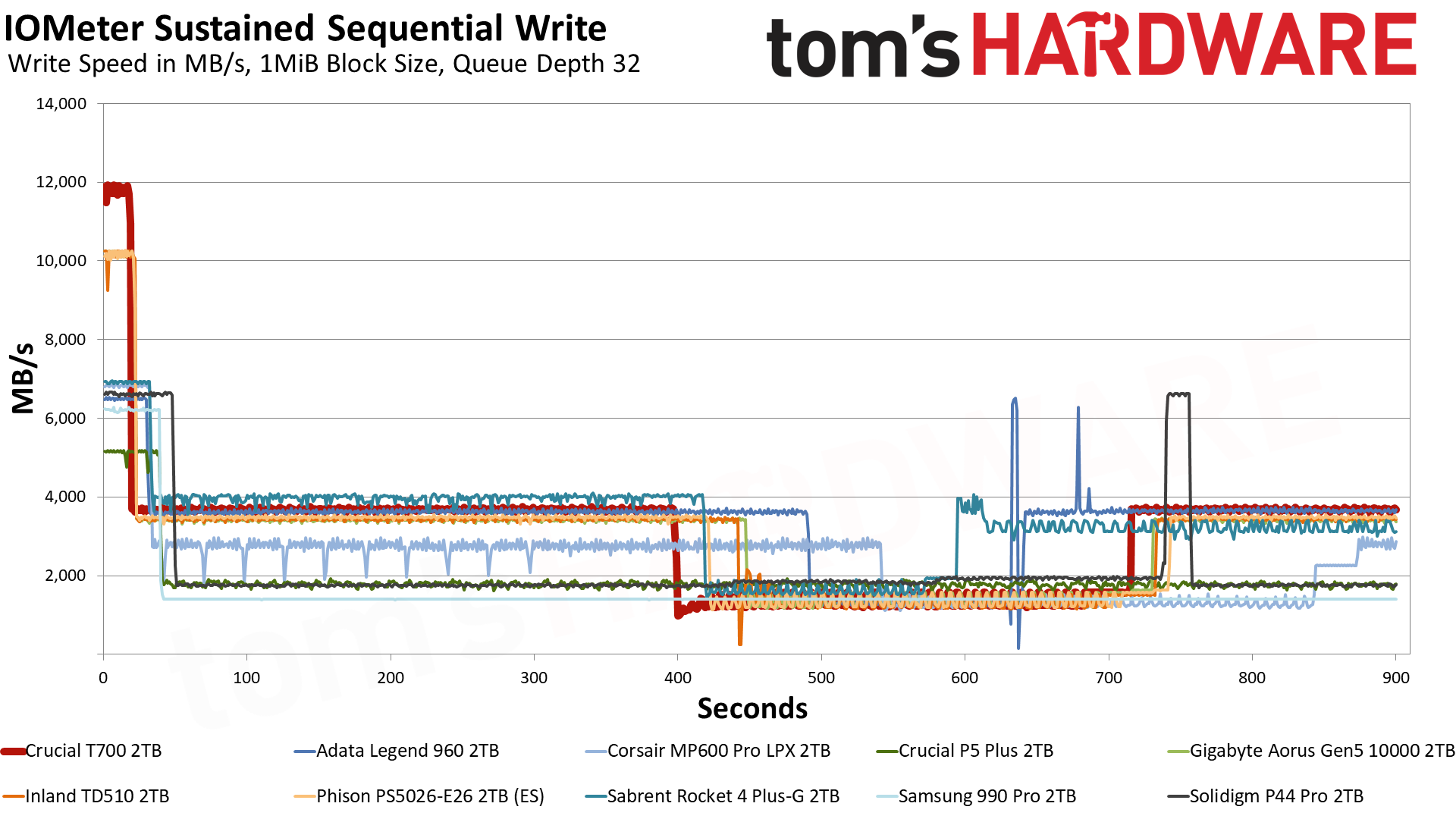
The T700 obviously needs a heatsink for heavy sustained write workloads. Sustained write performance starts high, hitting nearly 12 GBps in pSLC caching mode for over 20 seconds. This cache size is ample while still providing good TLC performance after depletion of around 3.6 GBps. A slower 1.4 GBps folding state follows, and on the whole, the post-pSLC pattern is reminiscent of what we saw with the Phison E26 sample: The improvement comes from the sequential burst speed.
Sustained performance may improve with a 4TB drive, and the peak will be higher with 2400 MT/s flash. The T700's recovery to TLC speeds is relatively rapid, but pSLC is unsurprisingly a bit slower to recover.
Power Consumption
We use the Quarch HD Programmable Power Module to gain a deeper understanding of power characteristics. Idle power consumption is an important aspect to consider, especially if you're looking for a laptop upgrade as even the best ultrabooks can have mediocre storage.
Some SSDs can consume watts of power at idle while better-suited ones sip just milliwatts. Average workload power consumption and max consumption are two other aspects of power consumption, but performance-per-watt is more important. A drive might consume more power during any given workload, but accomplishing a task faster allows the drive to drop into an idle state more quickly, ultimately saving energy.
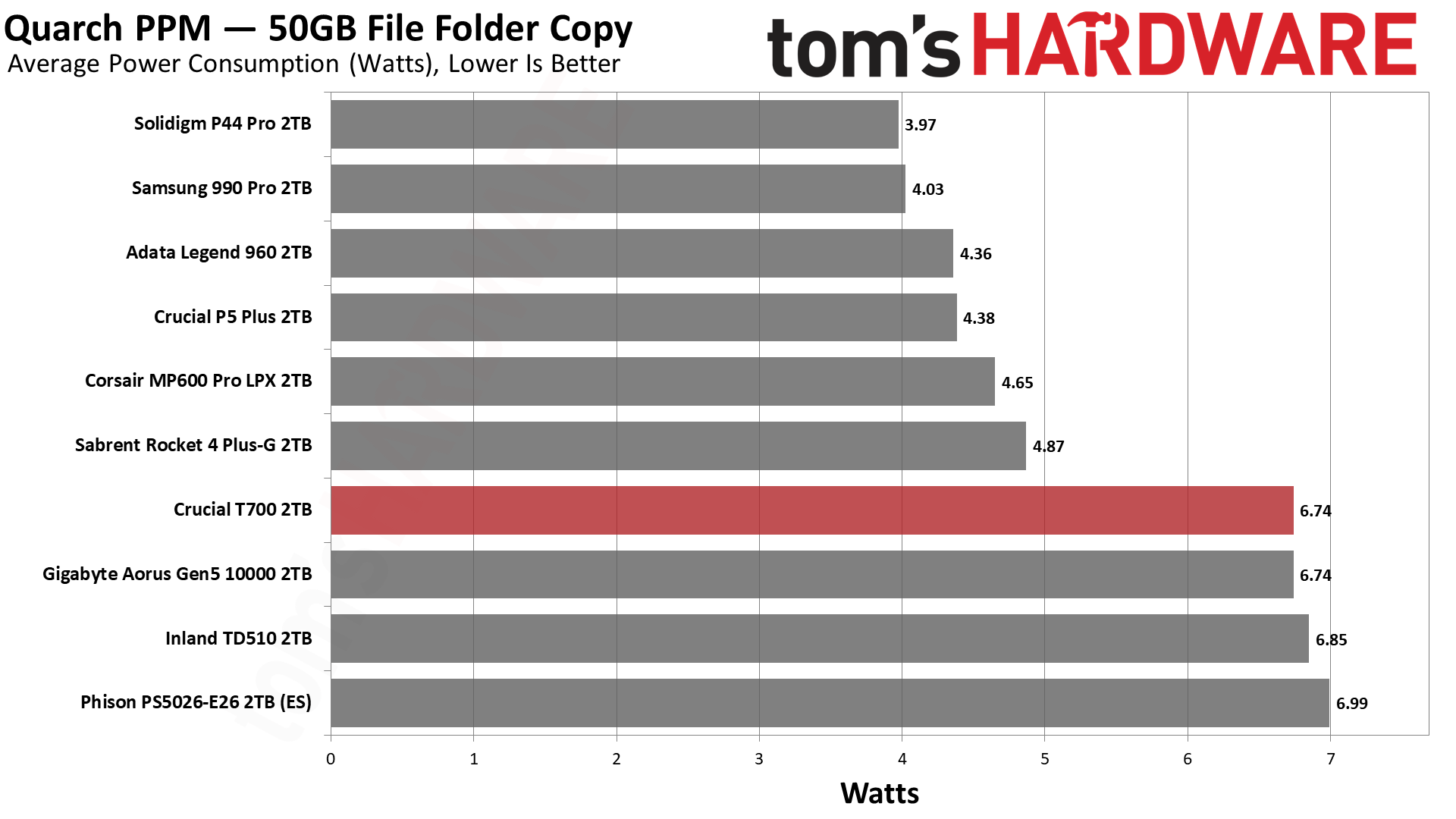
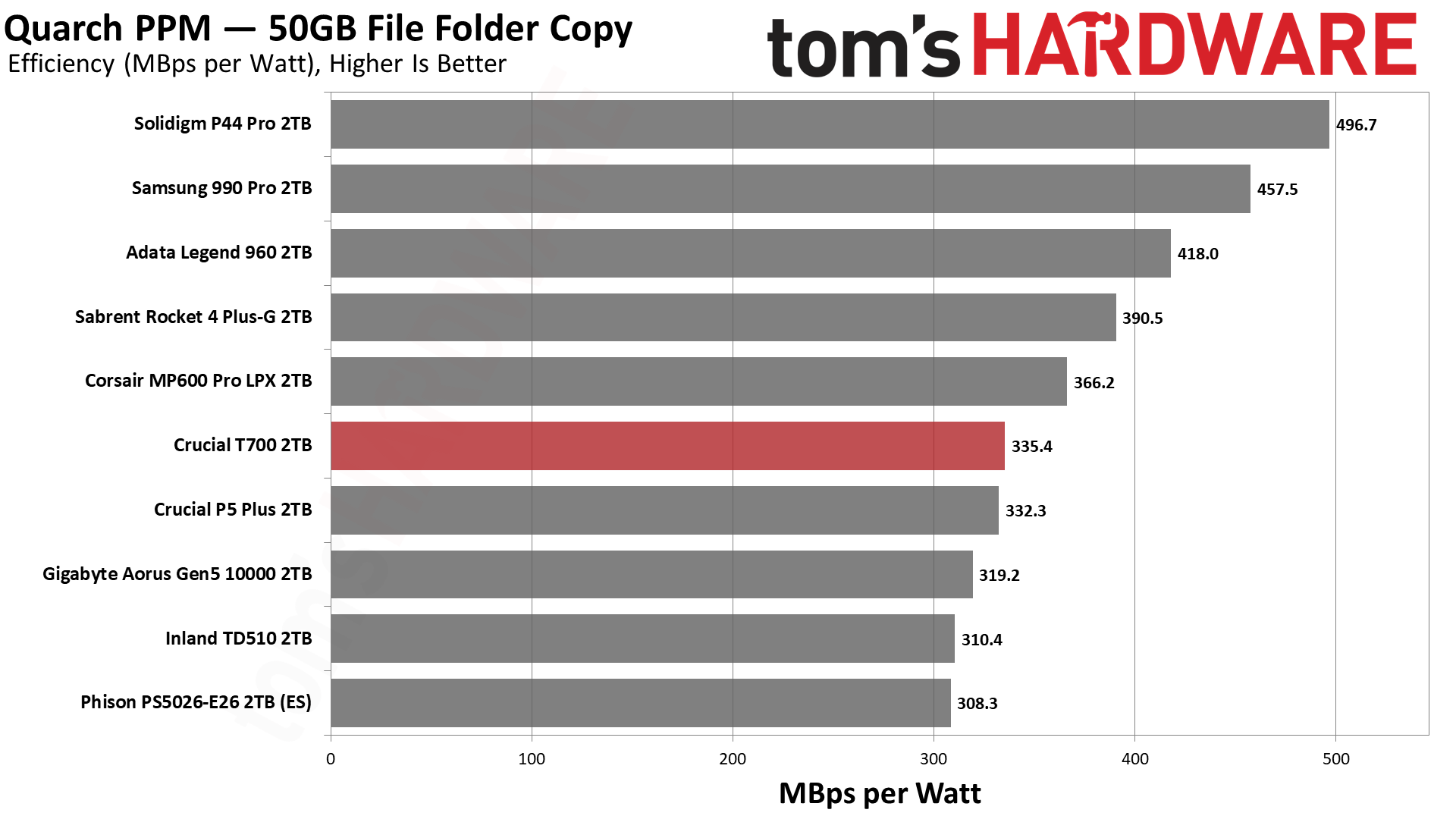
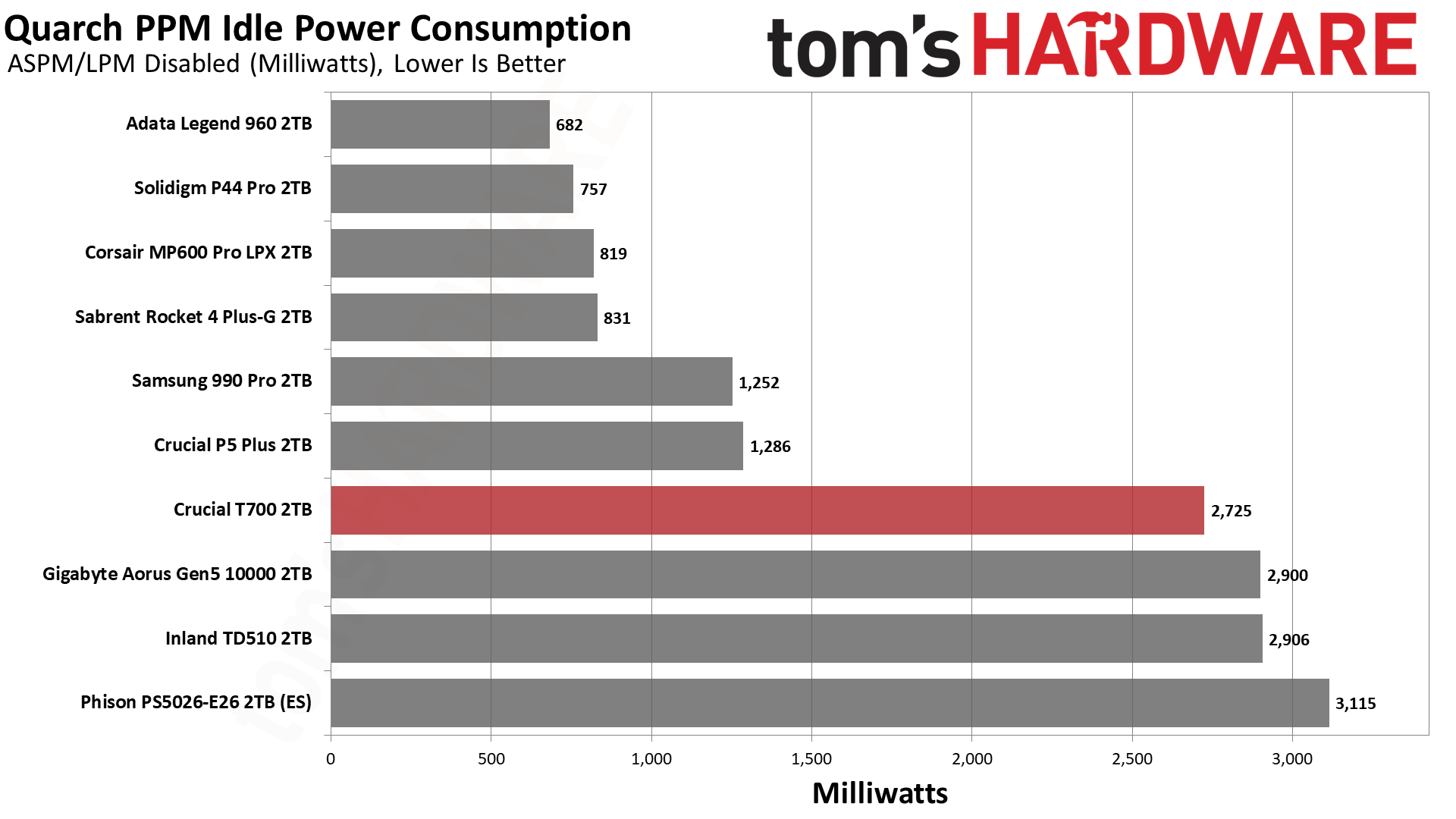
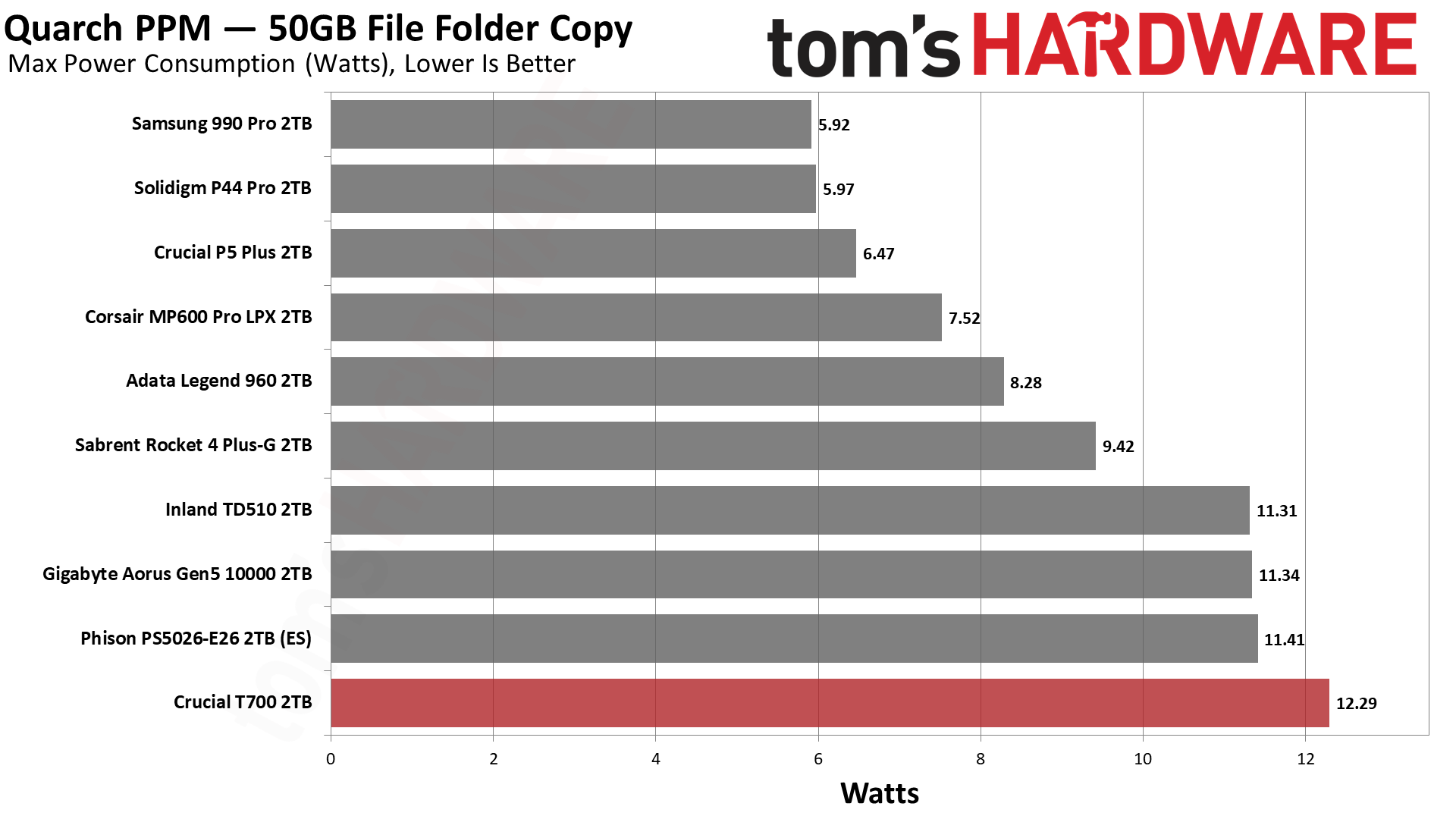
We want to immediately mention that Crucial is still optimizing the T700's power consumption in idle states. This did not impact our testing due to how we currently test, and it shouldn't be a huge factor anyway as this drive is not intended for laptop use.
The Crucial T700 is more efficient than the E26 ES, indicating that the controller is more efficient when able to run at higher speeds. This makes sense in our testing as the tests finish faster. This does mean higher peak consumption, making a heatsink all the more important for sustained workloads. Idle consumption with our desktop setup also shows improvement, and this controller is being optimized over time.
Test Bench and Testing Notes
We use an Alder Lake platform with most background applications such as indexing, Windows updates, and anti-virus disabled in the OS to reduce run-to-run variability. Each SSD is prefilled to 50% capacity and tested as a secondary device. Unless noted, we use appropriate cooling for all SSDs.
Bottom Line
The Crucial T700 takes a good thing and makes it even better. It’s hard to find fault with the product, especially as the non-Phison-reference heatsink is attractive and effective, and performance is equal to or better than other PCIe 5.0 drives. Faster, cheaper, and more capacious drives are on the way, and that’s a good thing.
There are a lot of DirectStorage skeptics, but Crucial seems pretty excited about the technology. The company is also especially proud to produce the fastest 5.0 SSD currently announced, even if it’s not using an in-house controller. The problem is that an announced drive isn't the same as a publicly available drive, and more critically, we don't have pricing details for the T700 yet.
When you look at the plunging SSD prices, you can now find good PCIe 4.0 2TB drives starting at just $120, like the Crucial P5 Plus 2TB. The T700 is unquestionably faster, but current Gen5 2TB SSDs start at $280 (Micro Center's inhouse-brand Inland TD510), and that's already $120 lower than the launch price from just a couple of months back. Unless you absolutely need maximum throughput, PCIe 4.0 drives are a far better value and are likely to remain so.
This is far from the only PCIe 5.0 SSD that Crucial has planned, but it's a nice surprise. The P5 and P5 Plus were also innovative in their own ways, although with proprietary controllers they have not held up well against the competition, except in pricing. And pricing is one area that Crucial has done well by introducing products like the P3 and P3 Plus. Unfortunately, Crucial hasn't shared pricing information for the T700 yet. However, we do know they'll arrive in a few months (by the end of the second quarter of this year).
Enthusiasts have been waiting for Crucial to bring out a leading-edge product, and the T700 looks to be just that. The key innovation is the use of higher speed Micron NAND, however, which is something other manufacturers can easily acquire. Whether they can match the T700 in other respects remains to be seen.
MORE: Best SSDs
MORE: Best External SSDs and Hard Drives
MORE: How We Test HDDs And SSDs
MORE: All SSD Content







